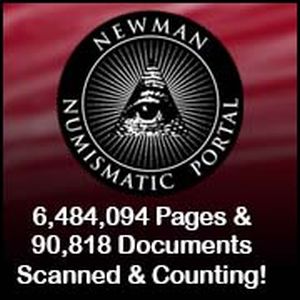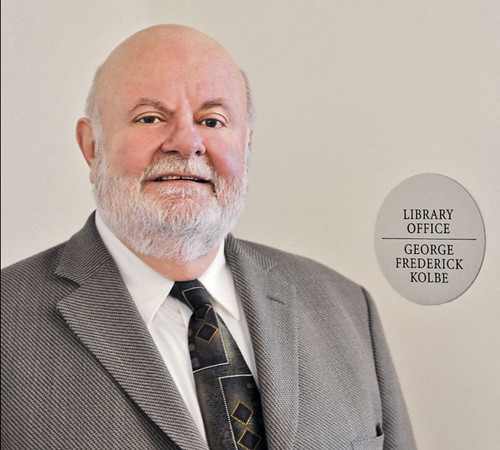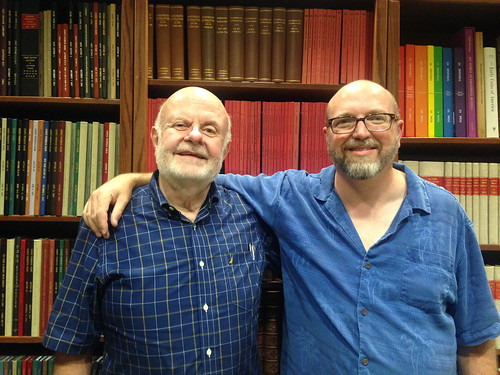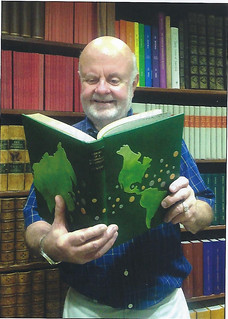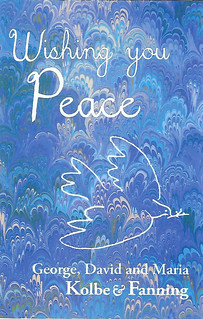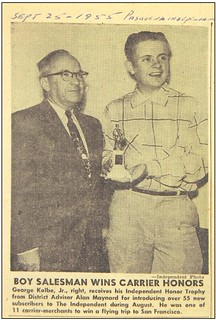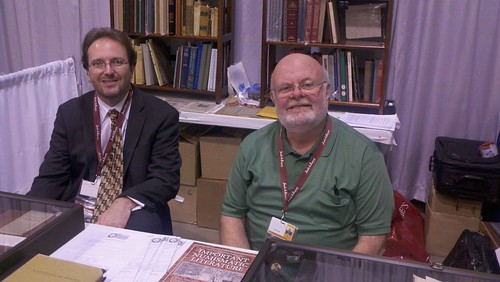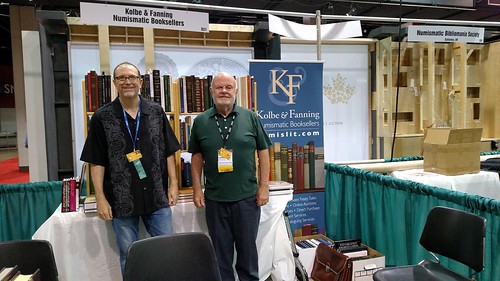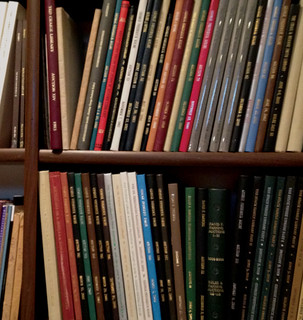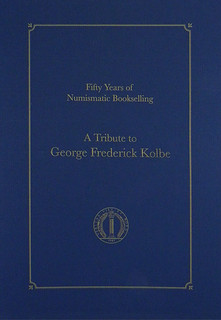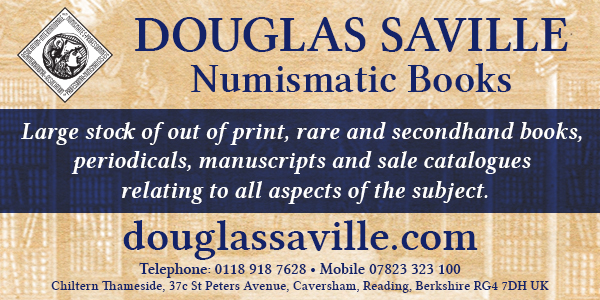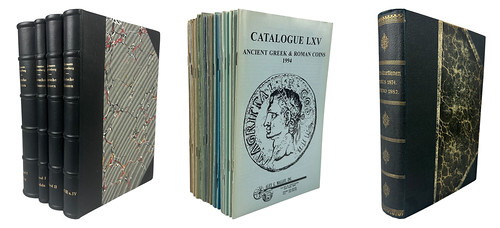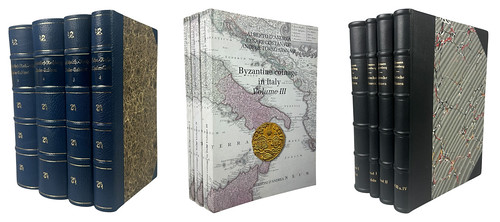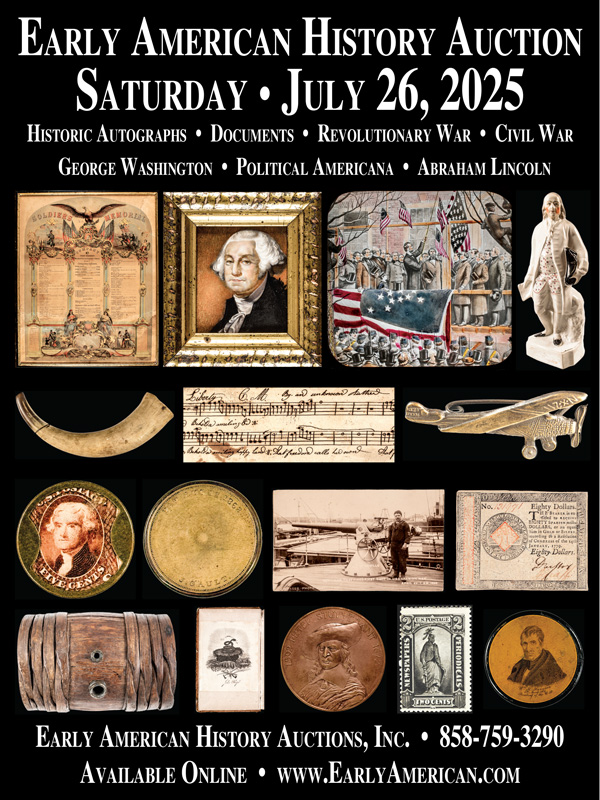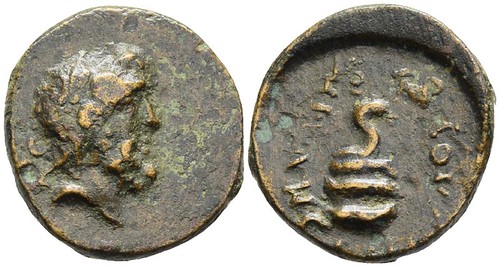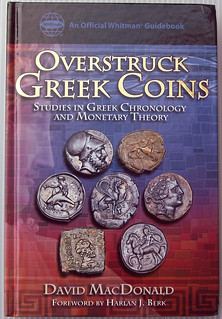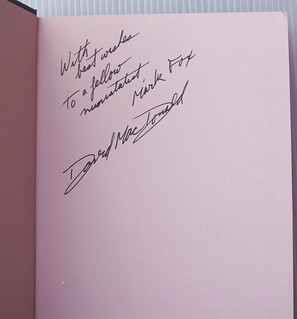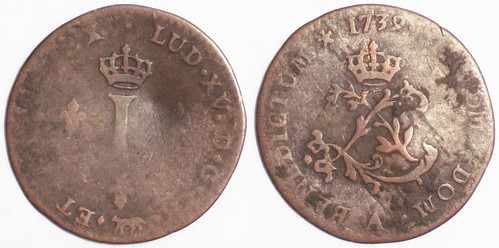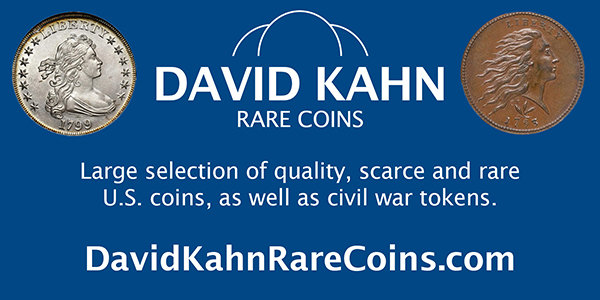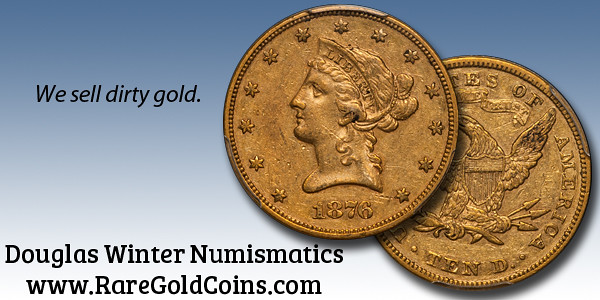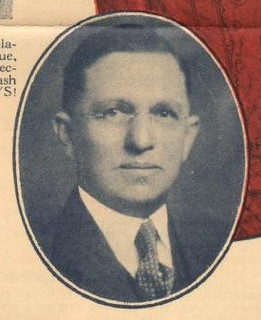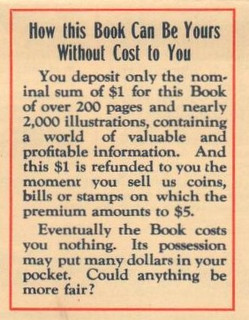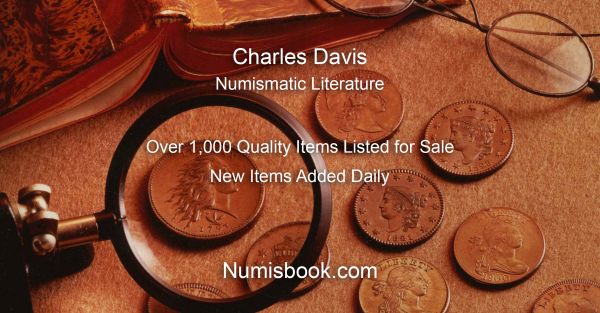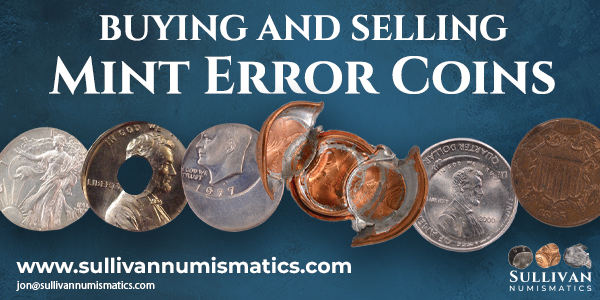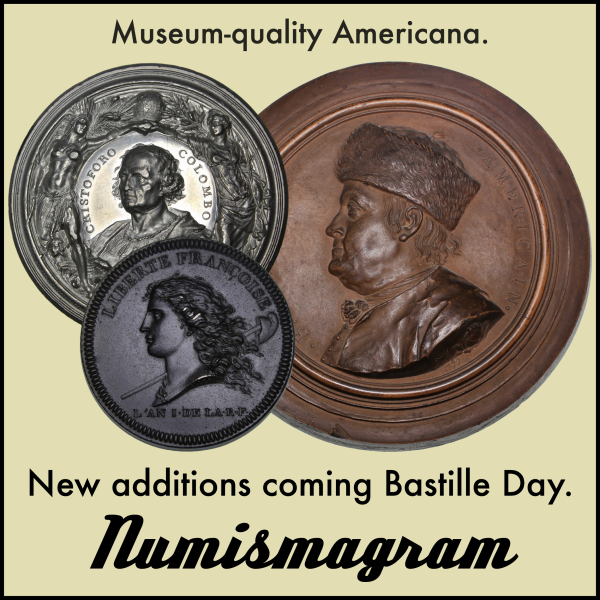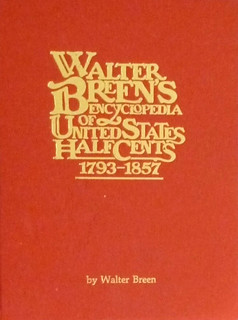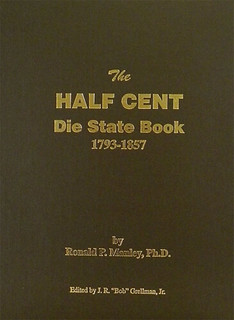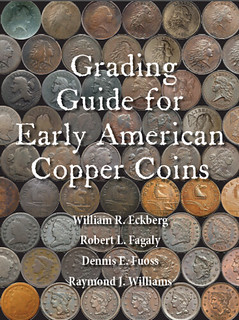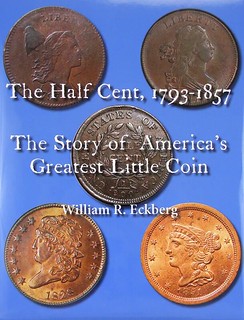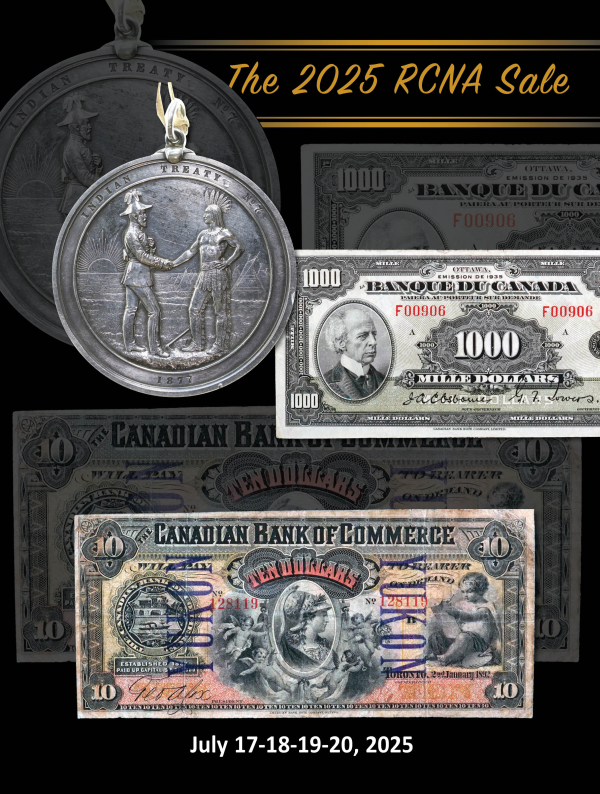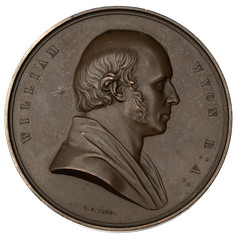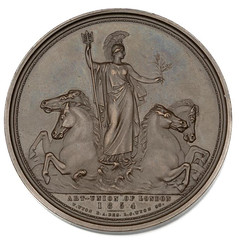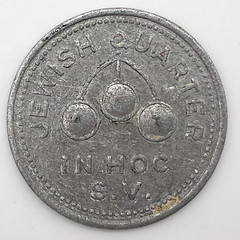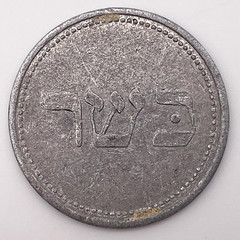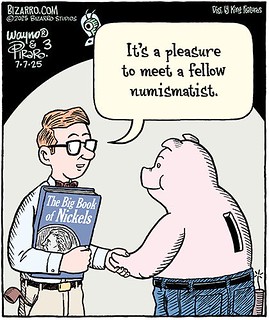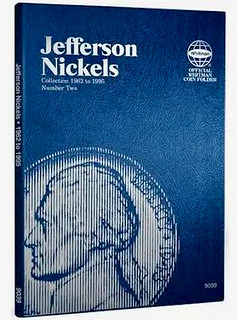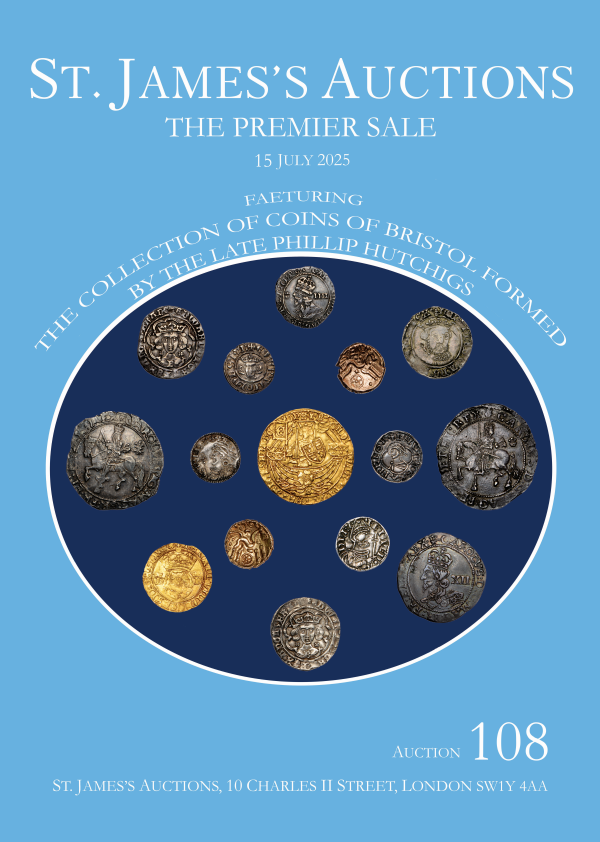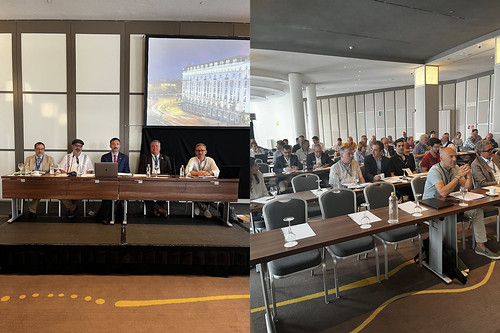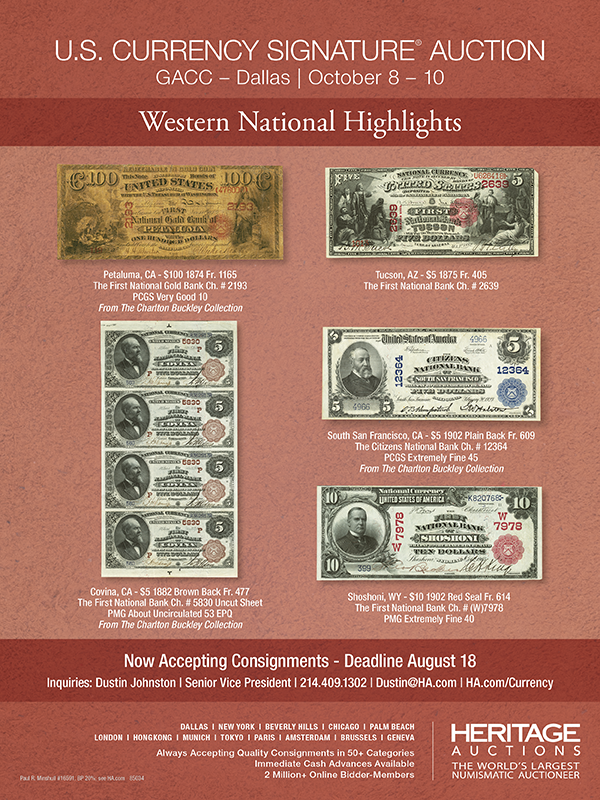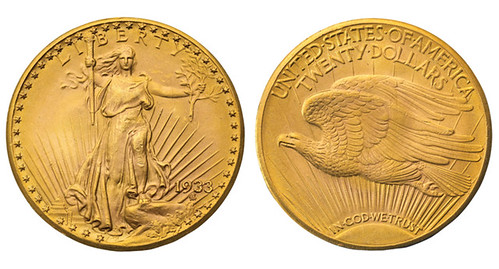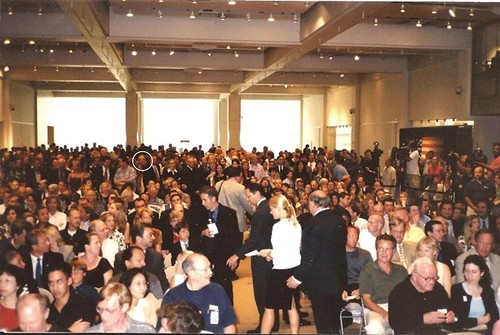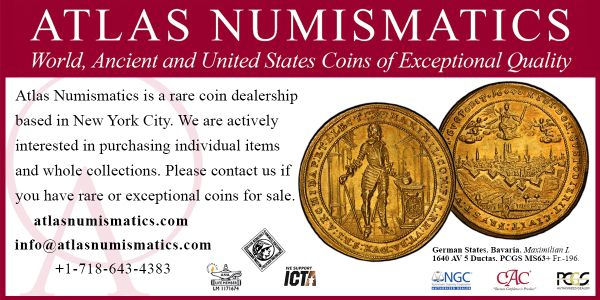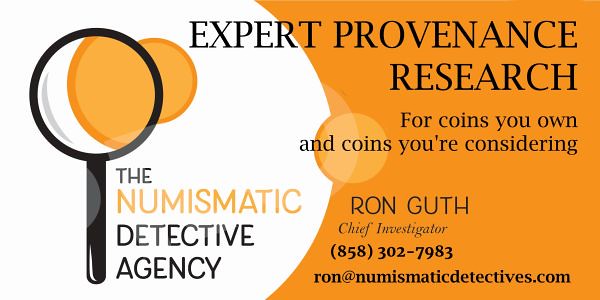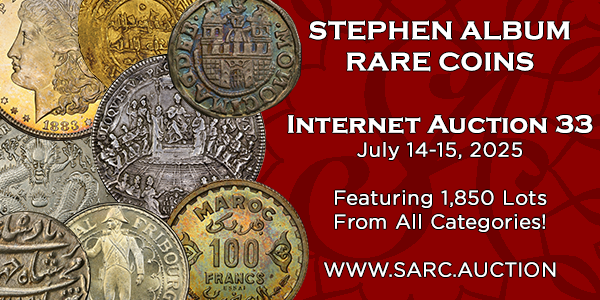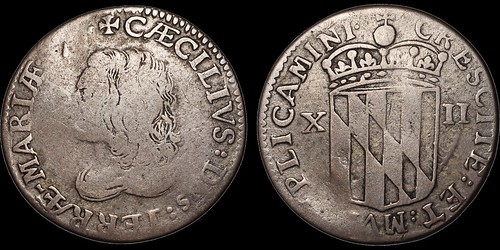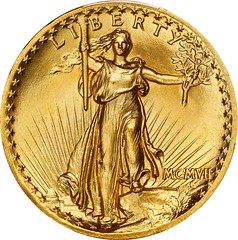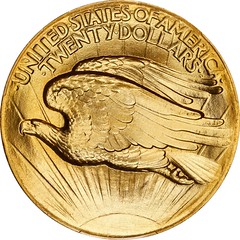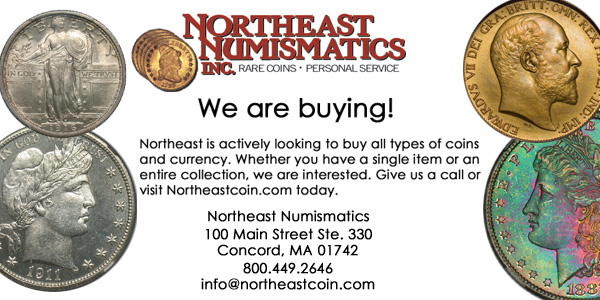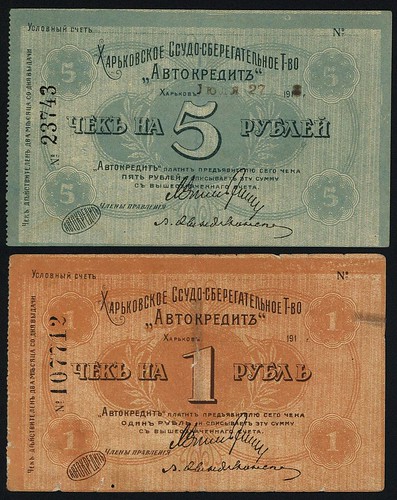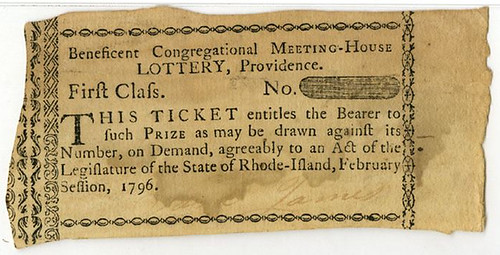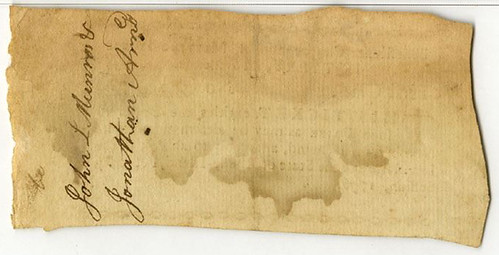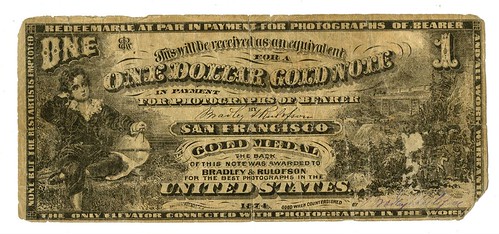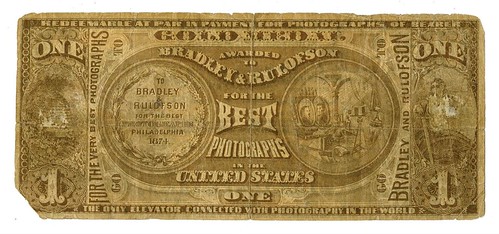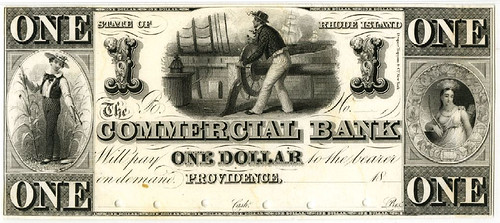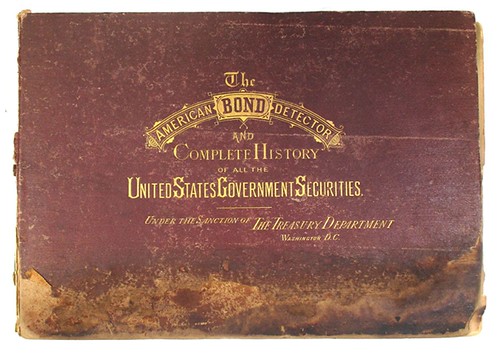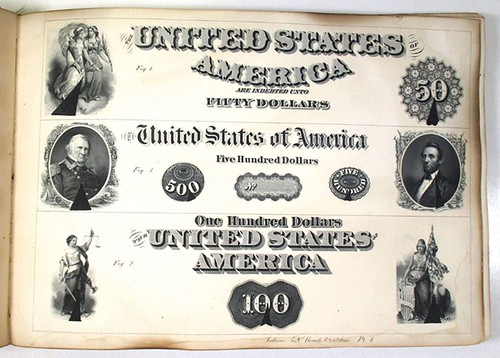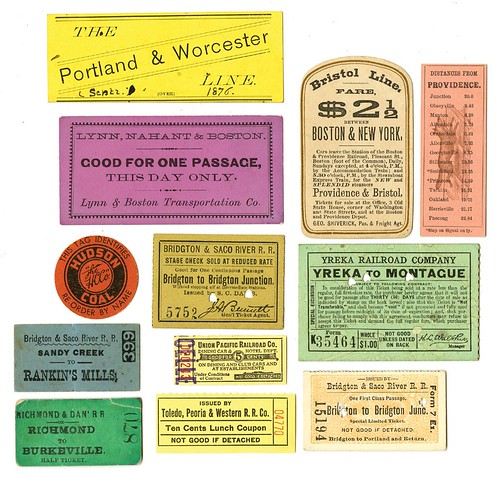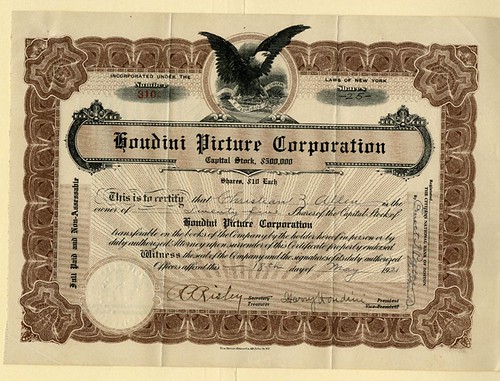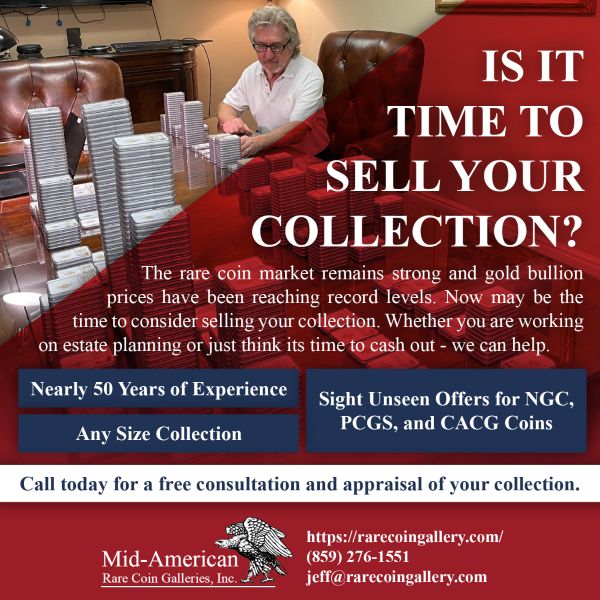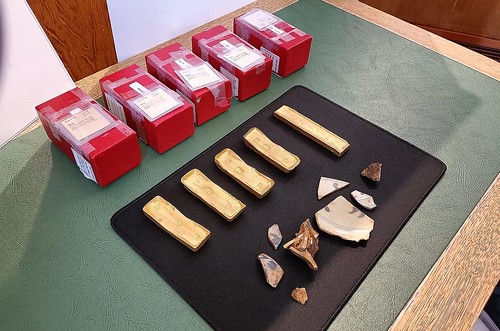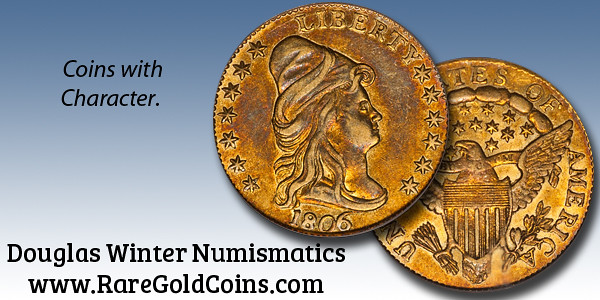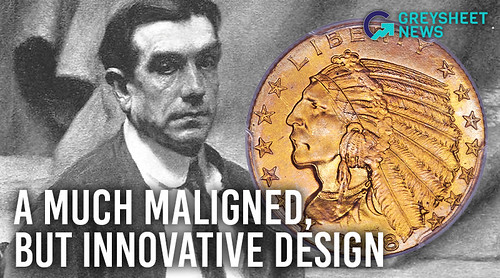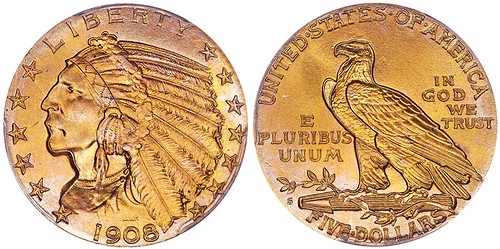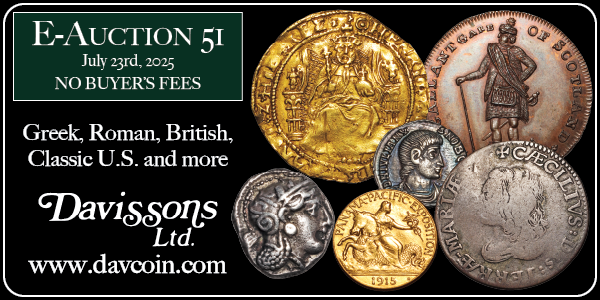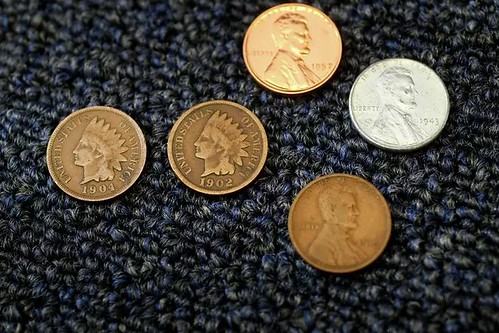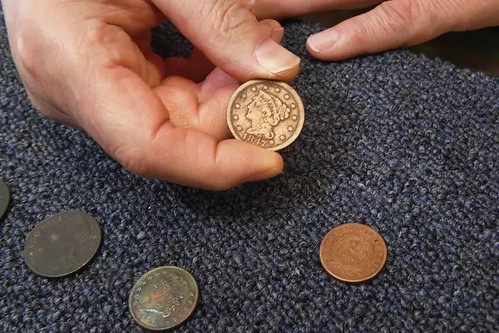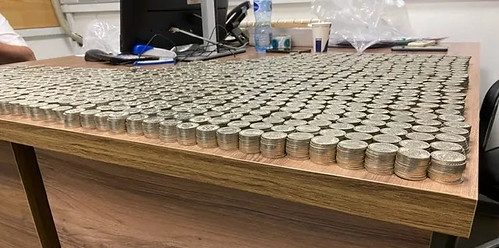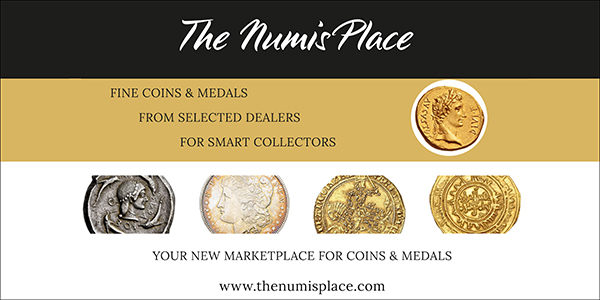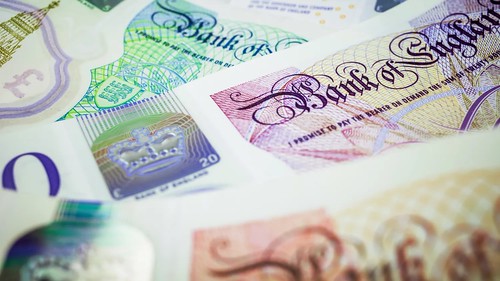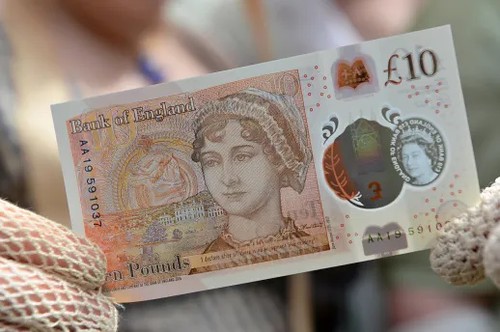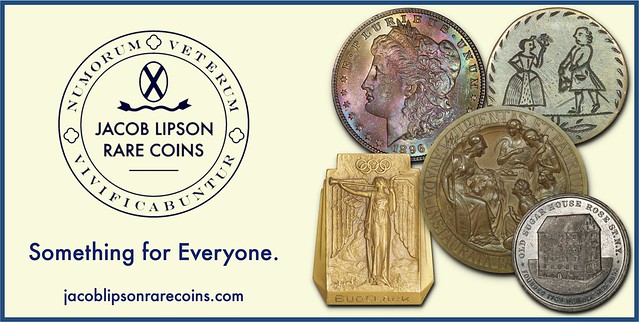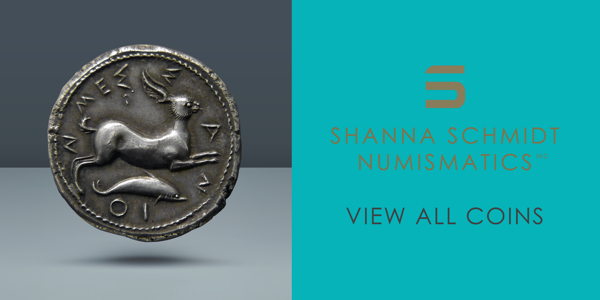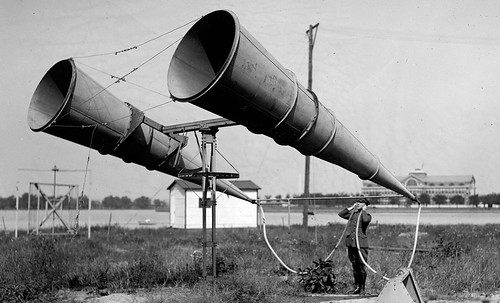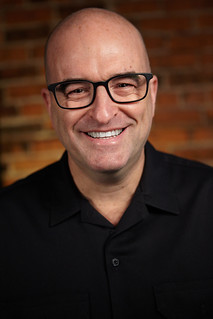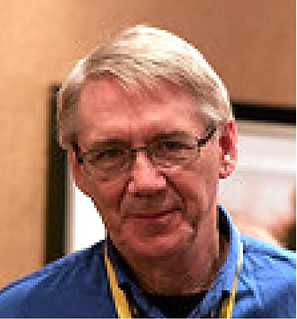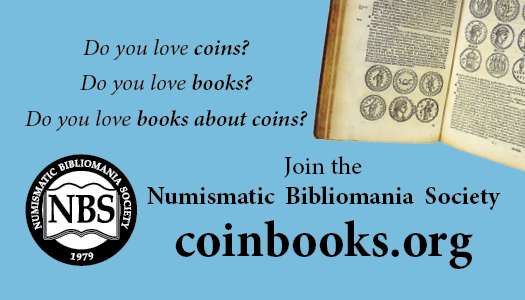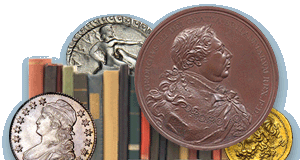
Visit our NBS Sponsors
About UsThe Numismatic Bibliomania Society is a non-profit association devoted to the study and enjoyment of numismatic literature. For more information please see our web site at coinbooks.org SubscriptionsThose wishing to become new E-Sylum subscribers (or wishing to Unsubscribe) can go to the following web page link MembershipThere is a membership application available on the web site Membership Application To join, print the application and return it with your check to the address printed on the application. Print/Digital membership is $40 to addresses in the U.S., and $60 elsewhere. A digital-only membership is available for $25. For those without web access, write to: Jeff Dickerson, Treasurer AsylumFor Asylum mailing address changes and other membership questions, contact Jeff at this email address: treasurer@coinbooks.org SubmissionsTo submit items for publication in The E-Sylum, write to the Editor at this address: whomren@gmail.com BUY THE BOOK BEFORE THE COINSale Calendar
|
- WAYNE'S WORDS: THE E-SYLUM JULY 13, 2025
- GEORGE FREDERICK KOLBE (1941–2025)
- LANG NUMISMATIC LITERATURE AUCTION 7
- BOOK REVIEW: NUMISMATIC LIBRARY OF SARAH BANKS
- DAVID JOHN MACDONALD (1943–2025)
- NNP SCANS STAR RARE COIN ENCYCLOPEDIA
- VIDEO: 1989 CONGRESSIONAL SILVER DOLLAR
- RECOMMENDED HALF CENT BOOKS
- NOTES FROM E-SYLUM READERS: JULY 13, 2025
- 2025 IAPN MADRID CONGRESS REPORT
- VOCABULARY TERM: MEDALLIST, MEDALIST
- THE ONE LOT 1933 DOUBLE EAGLE AUCTION
- ADAM CRUM REMEMBERS RON LANDIS
- THE LORD BALTIMORE SHILLING
- STACK'S BOWERS: RICK SPRINGFIELD SALE
- ARCHIVES INTERNATIONAL SALE 104
- LOOTED CHINESE GOLD BARS SEIZED
- PRATT'S UNUSUAL INCUSE DESIGNS
- THE CENT'S LEGACY
- COUNTERFEIT SWISS FRANCS FOUND IN KOSOVO
- BANK OF ENGLAND TO CHANGE NOTE DESIGNS
- CULTURAL CURRENCY MONEY ART EXHIBIT
- ABOUT THIS ISSUE: JULY 13, 2025
Content presented in The E-Sylum is not necessarily researched or independently fact-checked, and views expressed do not necessarily represent those of the Numismatic Bibliomania Society.
WAYNE'S WORDS: THE E-SYLUM JULY 13, 2025
 Last week readers got a bonus email - an announcement about the Archives International Auction 104. That was a glitch that slipped through accidentally. We don't sell our mailing list. We apologize for the confusion and additional email.
Last week readers got a bonus email - an announcement about the Archives International Auction 104. That was a glitch that slipped through accidentally. We don't sell our mailing list. We apologize for the confusion and additional email.
We're still working on a switch to a new email platform - MailChimp. We hope to complete this over the summer, and the switch should be seamless for readers with nothing to do on your part.
Thank you for reading The E-Sylum. If you enjoy it, please send me the email addresses of friends you think may enjoy it as well and I'll send them a subscription. Contact me at whomren@gmail.com anytime regarding your subscription, or questions, comments or suggestions about our content.
This week we open with the very sad news of the death of our co-founder, a new numismatic literature sale, a book review, updates from the Newman Numismatic Portal, and more.
Other topics this week include collector Sarah Sophia Banks, Mehl's Star Rare Coin Encyclopedia, the Congressional silver dollar, Half Cent books, medallists, the Farouk 1933 Double Eagle, the Lord Baltimore shilling, Ron Landis, Rick Springfield, auction previews, and money art.
To learn more about George F. Kolbe, Greek Overstrikes, the Wyon family of engravers, the IAPN Madrid Congress, the 1787 Brasher Doubloon repro, the American Bond Detector, Chinese gold bars, counterfeit Swiss Franc coins, and Notey McNoteface and the inherently unwell Frankendogs, read on. Have a great week, everyone!
Wayne Homren
Editor, The E-Sylum
GEORGE FREDERICK KOLBE (1941–2025)
Numismatic Bibliomania Society cofounder and U.S. numismatic literature dealer George Kolbe has passed. His partners David & Maria Fanning published this announcement yesterday. -Editor
We are heartbroken to announce the death of the founder of our firm, George Frederick Kolbe. George was known throughout the world as the foremost numismatic bookseller, having established his business in May 1967 and nurtured it over the course of the next fifty-six years into the world's largest independent firm specializing in numismatic literature. He was known to us as our mentor, our partner, and our friend.
Beginning with a modest three-page fixed price list sent to no more than two dozen potential customers, George placed great emphasis on his catalogues. Subsequent lists grew in sophistication, and in 1976 George held his first mail-bid sale. His first public auction followed in 1979. All the while he continued to grow professionally, producing informative and bibliographically rigorous catalogues. At the time of his retirement in 2023, George had been associated with some 168 auctions conducted under his name or (beginning in 2010) under the Kolbe & Fanning banner, many of which function as references within the field of numismatic literature.
A listing of notable libraries sold over the years would consist of too many names to include here, though the Harry W. Bass, John J. Ford, and Stack Family libraries require particular mention, as do the fifteen New York auctions conducted jointly with Douglas Saville of Spink. During his career, Kolbe also published The Numismatic Bookseller, which variably functioned as a house organ, fixed price list, and mail-bid sale, and founded the Numismatic Bibliomania Society with his friend Jack Collins. In 2012, Kolbe published a bibliography, The Reference Library of a Numismatic Bookseller, based on his personal working library.
A Life Fellow of the American Numismatic Society (ANS), George was the recipient of the 2005 Trustees' Award and, as such, was the honoree at the ANS Gala that year. George was also a Life Member of the American Numismatic Association (ANA), from which he received the Lifetime Achievement Award in 2019. He was a winner in 1995 of the ANA's Glenn Smedley Memorial Award and was recognized for his award-winning exhibit, Numismatic Bibliography 1579–1912: The Literature of Numismatic Literature,
at the 2011 ANA World's Fair of Money. George was elected to the honorary Rittenhouse Society and was a founding member of the Attinelli Fellowship, an honorary association of numismatic bibliophiles.
In 2010, George combined his well-established company with our fledgling business to form Kolbe & Fanning Numismatic Booksellers. His guidance and support in the early years of that partnership were essential to our development, and he was always available for advice and assistance whenever it was needed in more recent times. While George retired two years ago, the Kolbe & Fanning firm remains in business under that name, and will continue to do so moving forward.
George cherished the numerous friends he had made throughout the world during his long career, and was always grateful for the opportunities given to him through his involvement with numismatics. His loss is a heavy blow for us, but we take solace in the memories of the time we had with him.
David & Maria Fanning
KOLBE WINS ANA LIFETIME ACHIEVEMENT AWARD (https://www.coinbooks.org/v22/esylum_v22n31a02.html)
I was saddened to hear this news, but also glad to have been able to meet and know a giant in our field of numismatic literature. My first American Numismatic Association convention was the 1980 Cincinnati show where I attended a crowded presentation by bibliophile John J. Ford Jr., an event sponsored by the newly-formed NBS. Along with my local Pittsburgh friend John Burns, that event and my subsequent membership in NBS ignited my lifelong interest in numismatic literature.
Over the years I looked forward to meeting George at major coin shows and visiting him at his home in Crestline, CA. on a few occasions. One time while in L.A. for a business conference George organized a wonderful evening with NBS co-founder Jack Collins and fellow literature dealer John Bergman. And while returning from our Hawaiian honeymoon in 1997, my bride Dee and I visited George and his wife and later toured around the Lake Arrowhead area. I believe the last time we got together in person was at the NBS tour of Dan Hamelberg's library in 2019.
I reached out by email in early January. He said all was well, and regarding my recent Kolbe & Fanning consignment he wrote, "Very nice library. I bid on several lots - bought 1 or 2." I can't think of a nicer thing for a bibliophile to hear, from the nicest and most knowledgeable bibliophile of our time. That made my day. Curious, I just had to ask what he'd bought, and he wrote, 'A Hickcox and 1 or 2 others." My original 1858 copy of John H. Hickcox's An Historical Account of American Coinage had been a dream acquisition for my library, and one of my favorites. It was great to know George also appreciated its significance. That made my day all over again. Our last exchange was in March when I forwarded him a draft of an E-Sylum piece about Bonanza Press, a small California-based publisher that published numerous numismatic books in the early to mid 1970's.
Here's more information from the 2019 announcement of his ANA Lifetime Achievement Award. -Editor
Kolbe was born in 1941 and began collecting coins when he was 9 or 10 years old. He started selling them in the mid-1960s. Soon, he was buying current and out-of-print reference works on various numismatic topics and auction catalogs. Over several months, his appreciation of books and coins grew into a fledgling career as a numismatic bookseller, long before many specialized in the field.
Kolbe was a familiar face at antiquarian bookstores in Southern California and acquired a bounty of books. In May 1967 he began issuing modest lists of numismatic literature for sale, and his first auction was held in 1976.
Since then, Kolbe has distinguished himself as a promoter of numismatic literature. His scores of auction catalogs and fixed-price lists provide extensive descriptions of the books being offered, covering both their significance as repositories of information and their value as collectable items in their own right. He was the first numismatic bookseller to provide background information relevant to the books' histories and explain their importance as scholarly sources and artistic objects.
Kolbe has cataloged and conducted more than 150 numismatic literature auctions since 1976 and has issued dozens of fixed-price lists and other publications. The titles featured in these sales span the numismatic spectrum and include works published since the early 16th century. Some are written in languages other than English.
Kolbe has had the opportunity to sell some of the most notable libraries ever brought to market. His sale of highlights from the John J. Ford, Jr. Library achieved the highest price for a single-day numismatic literature sale—$1.66 million. He also sold the Stack Family Library for record prices and the Harry W. Bass, Jr. Library for more than $1 million. His sales of texts for the benefit of the ANA and the American Numismatic Society (ANS) generated funds for new acquisitions, and he has appraised literature donations to the ANA and ANS on behalf of donors, free of charge.
In 1979 Kolbe cofounded the Numismatic Bibliomania Society, and twice has served as editor of its journal, The Asylum. The society honored Kolbe by naming its highest award after him—the George Frederick Kolbe Award for Lifetime Achievement in Numismatic Literature. He belongs to the Antiquarian Booksellers Association of America, International Association of Professional Numismatists and, since 1987, the Rittenhouse Society. He also is a fellow of the Royal Numismatic Society.
In addition, Kolbe has published references about books, coins and medals. His support of niche titles has meant that valuable, but not commercially viable, research is available to collectors. In 2012 he wrote and published The Reference Library of a Numismatic Bookseller, recording the most comprehensive collection of numismatic bibliographies ever assembled, including works published in other languages, dating from 1579 to the present.
In 2010 Kolbe joined forces with David Fanning, Ph.D. to form Kolbe & Fanning Numismatic Booksellers, LLC. Kolbe celebrated his 50th year as an expert in numismatic literature in 2017. To honor the occasion, 28 numismatists contributed to the text Fifty Years of Numismatic Bookselling: A Tribute to George Frederick Kolbe published that year. In the introduction, Fanning wrote, One of the revolutionary aspects of George's catalogues was his introduction of formal bibliographic descriptions to an area of the hobby that was used to seeing simple lists of authors and titles. Part of this was salesmanship...but part of this was also an effort on his part to educate others, to share his knowledge.
NBS President Len Augsburger writes:
"It is hard to comprehend the loss of George Kolbe, and we will feel the impact of his absence for a long time. Simply put, George is one of the reasons we are all here today doing what we do. Numismatic literature was an afterthought for many years, with miscellaneous accumulations appearing here and there, and only the occasional offering of something more significant, such as the 1967 New Netherlands sale (no. 59) of the F.C.C. Boyd library. George changed all that by dedicating his professional career to the discipline, a bold bet that said to the collecting world, the literature of this hobby is compelling in its own right, and I'm going to prove it.
Prove it he did, with a long string of publications filled with scholarship and pearls of amusement for the careful reader. Only a toothpick and a piece of cheese are needed,
he wryly observed of one volume, with overly tight binding that suggested its use as a mousetrap.
"George, along with Jack Collins, spearheaded the formation of the Numismatic Bibliomania Society with an informal gathering at the 1979 ANA convention, followed by the publication of the first issue of The Asylum in 1980. The NBS provided a platform for researchers and collectors to explore the world of numismatic literature and to create the social connections that greatly enhance the collector experience. Today, the forty-plus years of The Asylum back issues provide a wide-ranging view of the field while at the same time delivering original research on more targeted topics. This is what we call multiplying
– although George was necessarily occupied with a commercial enterprise, he understood the importance of setting the stage so that others could contribute to the scholarship of the field.
"We are drawn into collecting by the artifacts themselves, but over time we understand that the greatest value of the hobby is not its history or objects, but the fellow travelers we come to know in our journey. George was ever generous with his knowledge, but more importantly he was one of the people who brought me into the circle, and for that I will be ever grateful. In 2017, David and Maria Fanning published a tribute to George, Fifty Years of Numismatic Bookselling. Such tributes tend to arrive after someone passes, but we can be thankful that George was able to hear firsthand from those fellow travelers
whose lives he impacted. Here's hoping that we can make the same sentiments known to all those who are similarly close to us."
George F. Kolbe Tribute in The Asylum
The Autumn 2025 issue of The Asylum will be a tribute to NBS co-founder George F. Kolbe. Please send any reminiscences or photos (especially older ones) of George to editor Maria Fanning at
asylum@coinbooks.org by September 1, 2025 to be included.
Dave Hirt writes:
"Sorry for the news that George Kolbe has passed away. I was a customer from the very start. I purchased an item with the invoice number 2. Also many items from his auctions. The numismatic literature world will miss him."
On Facebook Dwight Manley wrote:
"George brought class and brilliance to numismatics. He was a giving person, always happy to share knowledge, generous in sharing his time with all who asked. I warmly remember times with him and John Bergman, another great person we lost too soon, and listening to them go back and forth about literature and stories of the past. We are all fortunate he passed the baton to David Fanning, who has been nothing less than amazing as our leading numismatic bibliophile."
On Facebook Jeff Rock wrote:
"George was one of the greats in the hobby. I well remember the treacherous drive up to his mountain lair - which sounds like it should be for an evil villain! But instead it was to examine books that were in his current auctions, and often I had the chance to buy things that hadn't received any bids for whatever the opening price was set at. George and Jack Collins were instrumental in getting me interested in numismatic literature, and it is sad that both are now gone."
On Facebook Dan Freidus wrote:
"I'm so sorry to hear this. He was so knowledgeable and friendly over the 50 years I knew him. I had a few wonderful visits to him in the mountains."
John and Nancy Wilson of Ocala, FL write:
"We were very saddened to hear of the recent passing of George F. Kolbe in a post from his numismatic bookseller partner David Fanning. The passing of this numismatic auctioneer and bookseller is a great loss for our hobby. George started his business in 1967 and in 2010 joined David Fanning and the firm name was Kolbe and Fanning. George retired from the firm in 2023. David and his wife Maria carry on the name Kolbe and Fanning.
"George was one of the best auctioneer / booksellers who ever lived. He was also an author, speaker, researcher and exhibitor. He was very honest and well respected in the industry. George set up at many conventions, had auctions and price lists for the many years he had his own business. This trend continued when he joined with David Fanning. From when he had his own firm and later along with David Fanning, they sold many famous numismatic collectors' libraries. We are happy to have just about all their auction catalogs in our library.
"We have known all auction or bookseller firms that were in business since 1969. Most of them are now out of business. George was in the top one percent of all of them who were ever in business. We don't think anyone knew more about numismatic books then George did. He could answer any question on any numismatic book that was in existence. When our paths crossed, we always had cordial and friendly conversations.
"George received the ANA Glenn Smedley Memorial Award in 1995 and in 2016 their Lifetime Achievement Award. He belonged to many important coin club and was a life member of the ANA and a Fellow of the American Numismatic Society. In 2005 he received their Trustees' Award. In 1979 George and Jack Collins formed the Numismatic Bibliomania Society which continues today, https://www.coinbooks.org/. We have great memories of George and send our love and prayers to his family."
David Gladfelter writes:
"I can't begin to count the number of times that I have looked up information in George's catalogs, or relied on it to buy a book or write a story. He kept in touch by phone and email, always helpful and kind. He regularly published his own research, once taking up nearly an entire issue of The Asylum (quarterly journal of the Numismatic Bibliomania Society) with a story about the library of Martin Folkes.
"In retirement, George founded another literary organization, the Attinelli Fellowship, named in honor of publisher of the first American numismatic bibliography. Its purpose is social, and its annual dinners are where bibliophiles from all over gather to talk about literature important to them, and to have a fun time.
"Let me commend to all George's 2012 volume, The Reference Library of a Numismatic Bookseller, and his firm's 2019 illustrated catalog of the sale at auction of that reference library. I collect people as well as books, and I am touched by the kind inscription George wrote in my copy of his book. In the catalog is my favorite photo of George holding an artistically bound copy of that book. Let's just say that he is radiating joy. It's contagious.
"Go well, George."
Numismatic literature dealer Charlie Davis writes:
"When George published his library volume 13 years ago his cover letter to me noted we are both fortunate to have been around when a small window of opportunity opened to allow us to do exactly what we wanted
. Far too humble and I would add that George built that window and then opened it for several of us. His contributions to numismatics cannot be measured."
NBS Past President P. Scott Rubin of Lawrenceville, NJ writes:
"The passing of George Frederick Kolbe is a great loss to the numismatic fraternity. He helped make learning about the hobby easier for all current collectors. I say this as someone who started collecting numismatic literature by 1960. George and I became friends because of the founding of the Numismatic Bibliomania Society. At the time I was already a friend of his friend co-founder of the society Jack Collins.
"I cannot even remember when I first met George, but do remember that he used to issue catalogs of numismatic literature under the name G. Frederick Kolbe. Because of this, when we first spoke to each other he went by George Kolbe I would call him G. Frederick.
"George became one of the few people I ever shared rooms with at ANA conventions (to save money!). When I went on a family trip to visit one of my childhood friends in L.A. in the early 1990's, George invited me, my wife and daughter to visit him and his wife Linda in Crestline. We spent a wonderful day and stayed overnight at the house that was pictured on the cover on one of his auction catalogues.
"I will miss my many calls with George that continued until his untimely passing. We talked about our
families, trips we took, but always ended with a what is new in numismatics
question.
"George was lucky to have been married to two wonderful women. After the passing of Linda, he married Betty who spent some wonderful times with him and was there for him at the end.
For me a friend has passed but for numismatics George was thoughtful enough to make sure his legacy lives on through the Numismatic Bibliomania Society and his numismatic literature company, now known as Kolbe & Fanning Numismatic Booksellers."
NBS Historian Joel Orosz writes:
"When I started seriously collecting numismatic literature in 1982, George Frederick Kolbe was America's leading numismatic bookseller. Over the decades following, George helped me build a respectable numismatic library. He assured the continuation of his great firm by bringing David Fanning into partnership in 2010, and continued to be a mentor for us all. Even after he retired a couple of years ago, he still served, as the French would say, as an eminence gris
for the entire hobby. I cannot remember a time in numismatic bibliomania without him, and going forward without his immense presence seems unthinkable. A fond farewell to a pioneer, advisor, scholar, friend, and master of the bon mot, numismatic and otherwise."
George always referred to The E-Sylum as "The Big E." Here are some related images and articles we've published over the years. -Editor
For more comments on Facebook, see:
https://www.facebook.com/1046075557/posts/10232568241442277/
To read earlier E-Sylum articles, see:
NEW BOOK: THE REFERENCE LIBRARY OF A NUMISMATIC BOOKSELLER
(https://www.coinbooks.org/esylum_v16n05a04.html)
THE GEORGE KOLBE BOOKSELLER TOKEN
(https://www.coinbooks.org/esylum_v17n22a13.html)
LINDA KOLBE, 1942–2016
(https://www.coinbooks.org/esylum_v19n46a02.html)
NEW BOOK: 50 YEARS OF NUMISMATIC BOOKSELLING
(https://www.coinbooks.org/v20/esylum_v20n49a03.html)
GEORGE KOLBE PERSONAL LIBRARY SALE
(https://www.coinbooks.org/v22/esylum_v22n34a02.html)
GEORGE KOLBE RETIRES FROM BOOKSELLING
(https://www.coinbooks.org/v26/esylum_v26n46a02.html)
LANG NUMISMATIC LITERATURE AUCTION 7
The seventh numismatic literature auction from Numismatic Antiquarian Bookshop Lang closes May 15, 2025. Here's the announcement. -Editor
We are pleased to inform you that the Numismatisches Antiquariat Lang will hold its 7th auction on July 29, 2025 (16:00 CEST) with over 1,100 lots of numismatic literature. This auction is an exceptional opportunity for all lovers and collectors of numismatic literature to acquire rare and valuable works that should not be missing in any library.
- Auction details: Date: July 29, 2025
- Place: Online on the auction platform Auex.de
- Time: From 16:00 CEST
Highlights of the auction:
- First part duplicates of the BCD library among the auction catalogs
- Auction catalog series, important special collections and some stock lists
- Wide range of bibliophile works, general numismatics, antiquities, medieval and modern times as well as periodicals and other auction catalogs
The auction will be held online on the Auex platform, so you can participate conveniently from anywhere in the world. Further information on registration and the auction conditions can be found on our website. We recommend that you register early to ensure that you can take part in this unique event.
You will also have the opportunity to place pre-bids via the following platforms:
- Sixbid
- Biddr
- Numisbids
Should you have any specific questions or requirements, please do not hesitate to contact us.
We look forward to welcoming you to our upcoming auction on July 29, 2025 and wish you every success with your bids! Make a note of the date and be there!
For more information, or to bid, see:
https://auktionen.numismatisches-antiquariat.de/de-de/auctions/current
BOOK REVIEW: NUMISMATIC LIBRARY OF SARAH BANKS
Jeff Burke submitted this review of the Edward Besly book, The Numismatic Library of Sarah Sophia Banks. Thank you! -Editor
Review of The Numismatic Library of Sarah Sophia Banks, by Edward Besly
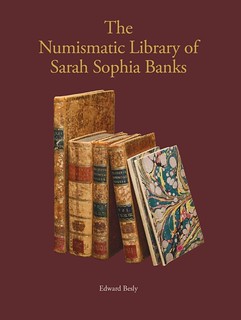 Noted numismatist and collector extraordinaire, Sarah Sophia Banks (1744-1818), lived in
London from 1780 with her brother, Sir Joseph Banks, a renowned botanist, and his wife,
Dorothea. Sarah collected books, coins, tokens, ephemera, and other objects of interest. Her
library, primarily assembled from the mid-1780s to 1818, is a rare surviving library from the late
eighteenth and early nineteenth centuries and its volumes cover three centuries. Following
Banks' passing, most of her books went to the British Museum (now British Library), but
Dorothea, her beneficiary, donated her numismatic library to the Royal Mint. In 1816, her
extensive collection of other numismatic items was also sent to the Mint. (Besly, The Numismatic Library of Sarah Sophia Banks, pp. 8-9.)
Noted numismatist and collector extraordinaire, Sarah Sophia Banks (1744-1818), lived in
London from 1780 with her brother, Sir Joseph Banks, a renowned botanist, and his wife,
Dorothea. Sarah collected books, coins, tokens, ephemera, and other objects of interest. Her
library, primarily assembled from the mid-1780s to 1818, is a rare surviving library from the late
eighteenth and early nineteenth centuries and its volumes cover three centuries. Following
Banks' passing, most of her books went to the British Museum (now British Library), but
Dorothea, her beneficiary, donated her numismatic library to the Royal Mint. In 1816, her
extensive collection of other numismatic items was also sent to the Mint. (Besly, The Numismatic Library of Sarah Sophia Banks, pp. 8-9.)
Banks' numismatic works form the catalogue of Besly's book on this historic figure. Besly's
catalogue assemblage was aided by referring to four extant lists of Banks's numismatic library:
two produced by Banks, one by her librarian, Jonas Dryander, and a fourth constructed by an
unknown writer. Besly opted to focus on the Dryander list to create a new catalogue of Banks's
library, because it serves as a window into Dryander's working methods and contemporary
‘best practice[.]'
(Besly, The Numismatic Library, p. 10). In addition, Dryander's list has more
bibliographic detail and extensive commentary than Banks's own lists.
Sarah obtained the first acquisition for her library, Jernigan's Lottery, at the age of ten, and
signed her full name in the volume. (Besly, The Numismatic Library, p. 11). Banks built up her
library through secondhand sources such as auction sales and the purchase of numismatic
reference books from personal libraries, including some put together by her friends. The vast
majority of the Banks's library is annotated. She chose not to emphasize literature on ancient
coins, even though books and catalogues in this area of specialization would have been available
to her in abundance. Instead, her library's strengths include the medieval period as well as
contemporary European coinage from her era. In stark contrast, she included few books or
pamphlets on the Islamic world or East Asia such as China or Japan. By the time of her passing,
Sarah's library contained approximately 302 titles relating to coins, tokens and medals bound in
331 volumes.
(Hugh Pagan, Sarah Sophia Banks: creation of a specialist numismatic library,
in The Numismatic Library, pp. 15, 18, 19).
As a conder token afficionado, I was delighted to find works by Thomas Spence and James Conder in the catalogue. (pp. 153 and 155). The latter figure gifted some of his works to Lady Banks.
This beautifully illustrated work provides readers with an inside view of a numismatic specialist and bibliophile, conducting transactions for her coins and books. For example, you can learn about her book annotations on the metal contents of specific coins (p. 98), manuscript number order (p. 119), correspondence about trial pieces made at the Royal Mint (p. 134), and Lambeth tokens acquired from a friend (p. 150). Appendix 3 (pp. 172-173) lists previous owners of Miss Banks's books. However, the author and title index (pp. 174-179) is in Lilliputian-size print which is difficult to read. This reference book is a significant contribution to British numismatic scholarship.
To read the earlier E-Sylum article, see:
NEW BOOK: NUMISMATIC LIBRARY OF SARAH SOPHIA BANKS
(https://www.coinbooks.org/v27/esylum_v27n26a03.html)
DAVID JOHN MACDONALD (1943–2025)
Mark Fox submitted this remembrance of his good friend David MacDonald. Thank you. -Editor
David John MacDonald (1943–2025)
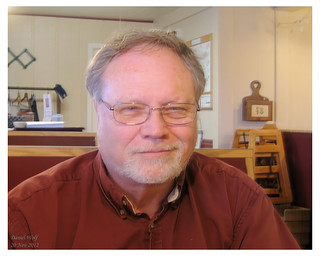 Numismatics lost a close friend and mentor earlier this year with the passing of David John MacDonald of Carlock, Illinois, on March 29, 2025, from an undiagnosed illness that culminated in a fatal case of pneumonia. He was born in Denham, Massachusetts, on June 26, 1943, to Charles MacDonald, a businessman, and his wife Virginia. Still with us are his wife Sharon, younger sister Laurie Dungan (born 1949) of Virginia, and sister-in-law Sheridan Sellers and grandnephew Jonathan Sweet of New York.
Numismatics lost a close friend and mentor earlier this year with the passing of David John MacDonald of Carlock, Illinois, on March 29, 2025, from an undiagnosed illness that culminated in a fatal case of pneumonia. He was born in Denham, Massachusetts, on June 26, 1943, to Charles MacDonald, a businessman, and his wife Virginia. Still with us are his wife Sharon, younger sister Laurie Dungan (born 1949) of Virginia, and sister-in-law Sheridan Sellers and grandnephew Jonathan Sweet of New York.
Many readers in classical numismatic or colonial history circles probably have at least crossed paths with some of Mac's work over the course of his voluminous writing career, stretching from 1969 to books and articles that have yet to be published, whether it be on Roman provincial coinage, Illyrian coins, Greek overstrikes, the Kingdom of the Bosporus, or French Illinois history, to name just a few.
For those who got to know him personally, a lasting friendship was often the result, filled with just as many chuckles as his vast research interests. He could perform the most extraordinarily thick Scottish accent this writer has ever heard, bordering on a different language. Many knew firsthand his tireless efforts to assist other scholars with their research, be available to share his wisdom on most any topic, or just simply listen. This was especially true for Dr. Daniel Wolf of Ptolemaic coinage fame who has already written a touching tribute to Mac on The PtolemyAE Project
Facebook page (https://www.facebook.com/PtolemyBronze). (The photo of David presented here was the result of Daniel's quick thinking during a visit with Mac at an Illinois diner in 2012.) Another close friend, Dr. Nicholas Molinari, a scholar on the Greek river god Acheloos and the founder and first general editor of the numismatic journal KOINON stressed, When I say none of my scholarly work would exist without his guidance I am not exaggerating at all.
At the same time, Mac was never afraid of confessing his ignorance when he did not have all the answers. That was because, like a true teacher, he was also a perpetual student, willing to learn from others with childlike wonder and fascination.
Mac was beloved by his students at Illinois State University where, in the history department, he taught as a professor for thirty-four years until his retirement in 2005. Since then, he cultivated an interest in French Illinois, Missouri, and the colonial history of the Americas.
Universities were in fact a very large part of his life. At California State University Fresno, where he received his first degree in history (BA) in 1965, he met his future wife Sharon, who he sat beside in the front row of Prof. John Bohnstedt's classroom. Sharon would later become an accomplished historian in her own right, specializing in medieval and U.S. Civil War history.
It took many years for this dense writer to fully realize the scope of Mac's accomplishments. That was partly because they were commonly hidden behind the blinds of his often-humorous sense of humility. Putting out offerings, for instance, was how he liked to explain his knowledge of computers, and yet, he was keen enough to recognize the research value of a hard drive from a notorious, bygone auction house that someone had carelessly thrown in the trash. Even more illustrative of the point was when Mac won the coveted 2017 Member of the Year award on the online discussion boards of FORVM Ancient Coins, of which he was an early member. Roughly a year after the award, he posted, I just discovered this. I am both amazed and a bit embarrassed. I do not even consider myself to belong in this category at all!
On a more serious note, the eminent Belgian numismatist, Prof. François de Callatay, soon after learning of Mac's passing, shared with Sharon that one of his regrets was not to meet his longtime friend in person, adding that Mac was unable to come to Brussels for the conference we had organized for him about ten years ago.
Mac had been instrumental in helping de Callatay create the Greek Overstrikes Database (https://silver.kbr.be/Greek_Overstrikes_Database), a research tool still in progress from its founding in 2010. The reasons for declining the conference are a bit uncertain, but Sharon noted to this writer that he was badly affected by the summer heat in 2015 and took a long time to recover. She further reflected, What a shame if that prevented him from going to Europe. But he never mentioned it to me (he was probably worried I would have put him on the plane one way or another).
The author's ancient Greek bronze (14.4mm, 2.737 g., 12h) of the Lydian city of Magnesia ad Sipylum in Asia Minor, kindly given to him by Mac. Combined photo courtesy of FORVM Ancient Coins.
Mac's extensive ancient and modern coin collections, built over the course of many decades, fueled his various research projects, but many coins were also clear mirrors of his impulsive side to coin collecting. One such piece was an unattributed Greek bronze with a right facing profile of Zeus on the obverse and a serpent entwined omphalos on the reverse. It was offered in a members-only FORVM auction which he obtained unchallenged for $12 in November 2022. The problem is,
he later wrote to me, I have no idea what I just bought! Any ideas? I think it will clean up better after a vigorous brushing!
My answer to him was a rare issue of Magnesia ad Sipylum in Asia Minor (a type cataloged in Dane Kurth's magnum opus on Lydian coinage as GRPC Lydia 38) and his grateful response was to give it to me.
All of Mac's coins (or those that have been located to date)—including his enormous numismatic library—were transferred after his death to the numismatic firm of Harlan J. Berk in Chicago where the majority of the material will be auctioned in multiple public sales. A tiny tip (75 coins) of this very large iceberg is currently being offered (as of this writing) in their 232nd Buy or Bid Sale, first launched on June 5. One exception to Mr. Berk's long-term auction plans is Mac's collection of overstruck Greek coins, which served as the basis for the latter's highly acclaimed book on the subject, Overstruck Greek Coins: Studies in Greek Chronology and Monetary Theory (2009), published by Whitman Publishing. These coins, and those apparently intended for an unpublished supplement were sold privately as an intact collection to an institution or individual to preserve their scientific value.
A celebration of life
was held locally for David on June 17, attended by several close friends, although some, including this writer, were sadly a little too far away to make the trip to southern Illinois.
The present tribute and recollection of one of the hidden titans of numismatics falls seriously short in many areas (e.g. his participation in archaeological excavations in Europe and Turkey), but it was never meant to be exhaustive. That is because a more thorough treatment on the life of David MacDonald is being readied for this year's volume (VIII) of KOINON, in which a detailed curriculum vitae for Mac will be provided. Would any E-Sylum readers who knew Mac like to contribute content to this project? A coin, a picture, a story, or even one of Macs's cynically droll jokes? All potential contributions, which will be appropriately credited, can be posted on E-Sylum or sent to marktfoxvdb@yahoo.com (because of current space limitations connected with my Gmail account) no later than early August since KOINON VIII goes to the printers on September 1.
Many thanks in advance for all interest shown. Mac would undoubtedly think all of this recognition was a bit too much, but that is too bad. Whether he wished to know it or not, he is worth it. We all miss you very much, Mac.
It was easy for Mac to bridge numismatics with his later love of French colonial history in Illinois and elsewhere. Seen here is a worn 1739-A Sou Marque (Vlack 17), graciously given to Mark Fox by Alan Anthony to forward on to Mac for his 69th birthday. Photo by Mark Fox.
NNP SCANS STAR RARE COIN ENCYCLOPEDIA
The latest addition to the Newman Numismatic Portal is a partial run of B. Max Mehl's Star Rare Coin Encyclopedia. Project Coordinator Len Augsburger provided the following report. -Editor
Newman Portal Scans Star Rare Coin Encyclopedia
Recently scanned by NNP is a partial run of B. Max Mehl's prices paid for list, aka the Star Rare Coin Encyclopedia. Probably the best-selling numismatic book of all time, apart from the Guide Book of United States Coins, Mehl published at least sixty editions, with the sixty-first (1959) being the latest reported by
worldcat.org. Mehl thus played a significant role in the formation of coin consciousness
among the American public, even prior to the advent of the ubiquitous coin boards in the 1930s.
Charles Davis quotes Walter Breen's opinion of the Mehl publication as numismatically worthless,
and, while the Star Rare Coin Encyclopedia is unlikely to ever be cited as presenting original research, it remains an important publication in the evolution of American numismatics.
Images: Extracts from the B. Max Mehl flyer Amazing Profits for those who know OLD MONEY, offering the Star Rare Coin Encyclopedia for sale at one dollar per copy
Link to Star Rare Coin Encyclopedias on Internet Archive::
https://archive.org/details/newmannumismatic?tab=collection&query=%22star+rare+coin+encyclopedia%22&sort=-publicdate
VIDEO: 1989 CONGRESSIONAL SILVER DOLLAR
The David Lisot Video Library on the Newman Numismatic Portal can be found at:
https://nnp.wustl.edu/library/multimediadetail/522852
We highlight one of his videos each week in The E-Sylum. Here's one with Michael S. Turrini speaking about the special striking ceremony for the 1989 Congressional Commemorative Silver Dollar. -Editor
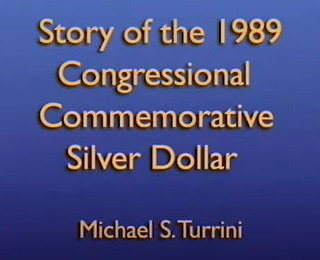 On June 14, "Flag Day," a unique event in American numismatics occurred: it was the only time that U.S. coinage was struck outside one of the official mints. The event was in Washington, D.C., for the first strikes of the Bicentennial of Congress commemorative coins, and the presenter took one of the few photographic records of the day. Michael S. Turrini is an ANA Life Member and the current National Coordinator of the Club Representative Program.
On June 14, "Flag Day," a unique event in American numismatics occurred: it was the only time that U.S. coinage was struck outside one of the official mints. The event was in Washington, D.C., for the first strikes of the Bicentennial of Congress commemorative coins, and the presenter took one of the few photographic records of the day. Michael S. Turrini is an ANA Life Member and the current National Coordinator of the Club Representative Program.
Speaker: Michael S. Turrini.
To watch the complete video, see:
Story of the 1989 Congressional Commemorative Silver Dollar
(https://youtu.be/kN6I3nMwvpo)
Story of the 1989 Congressional Commemorative Silver Dollar
(https://nnp.wustl.edu/library/book/557339)
RECOMMENDED HALF CENT BOOKS
Bill Eckberg submitted these notes in response to Roger Burdette's request for information on half cent books. Thank you! -Editor
There really are four books and one series that are worth owning.
The first book is Walter Breen's Encyclopedia of United States Half Cents, 1793-1857 by, obviously, Walter Breen. Published in 1983, it has a LOT of information about coinage deliveries and a pretty good emission sequence. Most of the photos are grayscale, but there are color plates of beautiful examples of each year in the back. Also, lots about errors and how they came about. It offers interesting but limited insight on grading. However, some of the information is out of date.
Next is Ron Manley's 1998 Half Cent Die State Book. It is exactly what it says it is, and most dealers and auction companies use Manley die state information.
The Grading Guide for Early American Coppers, by Bill Eckberg, Bob Fagaly, Dennis Fuoss and Ray Williams, was published by Early American Coppers in 2014. It uses full color images of each of the different types in all grades from AG-MS-67, where such coins are known. The book, which received the Numismatic Literary Guild Book of the Year award, covers half cents, large cents and the collectible federal and state coinages produced under the Articles of Confederation. It remains the bible for EAC-style grading.
The fourth is my The Half Cent, 1793-1857: America's Greatest Little Coin, published in 2019. It shows the products of each obverse and reverse die as well as all of the edge dies and provides the most up to date emission sequence. It was the first half cent book to illustrate everything in full color with large photos, mostly by the author. It uses line drawings to illustrate the amount of detail required at each grade level. It also focuses on how and when each variety was created.
The above books are all out of print and available from booksellers on the secondary market.
More recently, Ed Fuhrman has produced a series of books on each of the half cent types, with a separate volume on errors, another on attribution and a third on grading. The set gives Ed's views on cherrypicking. The cost of the set of six books is over $500. To the best of my knowledge, these are still available from the author.
A mention needs to be made of Roger Cohen's American Half Cents: the Little Half Sisters, published in two editions, the second in 1983. It was the book that popularized half cent collecting. We still collect half cents by Cohen (C) number, although Cohen's emission sequence has been shown to be wrong in several cases. The book is only of historic interest, as all of the books listed above have rendered it obsolete.
To read the earlier E-Sylum article, see:
NOTES FROM E-SYLUM READERS: JULY 6, 2025 : Best Modern Books on Certain Coins?
(https://www.coinbooks.org/v28/esylum_v28n27a09.html)
NOTES FROM E-SYLUM READERS: JULY 13, 2025
The Wyon Family of Engravers
Cary Bown writes:
"Regarding the 1854 Art Union of London Medal of William Wyon, I like the reverse design of Brittania. I recently came across this medal in the book "The Wyons" by Leonard Forrer, Reprinted from the Biographical Dictionary of Medallists, Vol. VI. Published by Spink & Son Ltd. London 1917. It can be found online at HathiTrust.org.
"The medal is signed on the obverse under the neck: L.C. Wyon - Leonard Charles Wyon, the eldest son of William. The story of the Wyon family's association with the British Royal Mint as engravers, several occupying the Chief Engraver position, as William did, is amazing. In addition, several others held the office of Chief Engravers of His or Her Majesty's Seals. William's coinage work included those bearing the image of King George IV, William IV and Queen Victoria. The list of coins and medals whose dies the Wyons produced is extensive. Anybody who has ever appreciated a 19th century British coin or medal, might look to one of the Wyons.
"The cover of the July 2025 issue of The Numismatist features an East India Company One Mohur gold piece; William had a role in the production of that coin in that he made a wax model from eminent sculptor John Flaxman's Lion and Palm Tree design that was initially considered for the obverse of an East India Company silver One Rupee coin but ultimately chosen for the reverse of the One and Two gold Mohur coins. Flaxman may have been inspired by the Siculo-Punic coins of the late 4th century bearing a very similar design for the reverse."
I like the reverse as well, and that's what initially caught my eye. Be on the lookout for a long-awaited book by Mark Jones on engraver William Wyon, to be published by SPINK. -Editor
To read the earlier E-Sylum articles, see:
NEW BOOK: WILLIAM WYON
(https://www.coinbooks.org/v25/esylum_v25n27a02.html)
NEW BOOK: WILLIAM WYON
(https://www.coinbooks.org/v28/esylum_v28n18a03.html)
NUMISMATIC NUGGETS: JULY 6, 2025 : 1854 Art Union of London Medal
(https://www.coinbooks.org/v28/esylum_v28n27a20.html)
On the Jewish Quarter Token
I asked Ira Rezak about this piece. He writes:
"I've seen this previously. In my view, this is a satirical/anti-semitic piece...choose one of the alternatives as you wish. It's like altered Hobo nickels where sometimes the Hobo is exaggerated Jewishly and the reverse has a Jew sitting on a toilet.
"In hoc signo vinces is a well known Christian triumphalist phrase (see Wikipedia entry for the history). The Hebrew translates as "Kosher". The three balls are those of a pawnbroker's sign. Thus the Jew as pawnbroker/tradesman is represented as proclaiming that he is ironically triumphing, over whom? Well, obviously over his Christian customers. And he's calling the actions kosher, i.e. in accordance with Judaism, when again, obviously everyone knows that Jews, especially pawnbrokers, are sharpers."
Thank you. While European cities often have a Jewish Quarter, I was unaware of a U.S. city with a section so named. Odd piece. Sorry to publicize it, but glad now to know the background. -Editor
To read the Wikipedia article, see:
In hoc signo vinces
(https://en.wikipedia.org/wiki/In_hoc_signo_vinces)
To read the earlier E-Sylum article, see:
NUMISMATIC NUGGETS: JULY 6, 2025 : Unknown Jewish Quarter Token
(https://www.coinbooks.org/v28/esylum_v28n27a20.html)
Article on Anting-Anting Medals
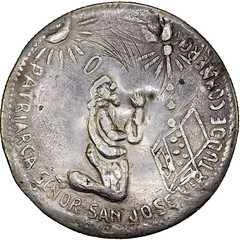 Jeff Starck writes:
Jeff Starck writes:
"I couldn't help but notice the reference in the latest edition to Anting-Anting medals. Coin World had a story about one such piece in its Readers Ask column in the July 29, 2024 issue (page 15). It was the first time I had heard of them, too."
To read the earlier E-Sylum articles, see:
NUMISMATIC NUGGETS: JUNE 29, 2025 :
Philippines Anting-Anting Medal
(https://www.coinbooks.org/v28/esylum_v28n26a20.html)
NOTES FROM E-SYLUM READERS: JULY 6, 2025 :
More on Philippines Anting-Anting Medals
(https://www.coinbooks.org/v28/esylum_v28n27a09.html)
Matlock Coin Thief Episode
Howard Berlin writes:
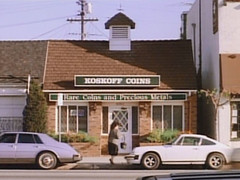 "Over the years there have been many television shows that involved numismatics as part of the storyline. A recently aired two-part episode of
"Over the years there have been many television shows that involved numismatics as part of the storyline. A recently aired two-part episode of Matlock,
titled The Thief
that was originally aired in 1989, involved a coin store employee who periodically stole rare coins from his employer's safe to pay off his gambling debts. The store is Koskoff Coins, whose name is strikingly similar to the real long-time US coin dealer Abe Kosoff. When the store's owner, Mike Koskoff (John Harkins), discovers the employee's thefts and his deletions from the computer's inventory, he confronts the thief and demands the coins' return or $40,000.
"When the employee is found murdered, Koskoff, whose gun is the murder weapon, is arrested and hires his friend Matlock (Andy Griffith) to defend him. Matlock inquires is the employee stole early American
coins and inquired about Koskoff's 1804 silver dollar, which Koskoff said was still in the slabbed case.
"Matlock then shows his numismatic knowledge, particularly with US dollars, when he said he found a 1850 Liberty Seated Silver Dollar at a store in a nearby city in fair' condition. Koskoff mentions some of the rarities still in the store's safe, such as a 1804 dollar and a 1838 Gobrecht proof. To pay Matlock's high fee (often $100,000 as a retainer), Koskoff offers Matlock the 1804 silver dollar. However, Ben wants the
Liberty Seateds through 1851
to seal the deal. Ben assures Koskoff that he won't sell them and Koskoff can come over to see them anytime. As to be expected, Matlock gets Koskoff acquitted."
Thanks for the report! You'd mentioned this one before, but without these details. There are screenshots on the "Coins on Television" website. -Editor
To read the earlier E-Sylum article, see:
NOTES FROM E-SYLUM READERS: FEBRUARY 20, 2022 :
TV Episodes with Coins in the Plot
(https://www.coinbooks.org/v25/esylum_v25n08a09.html)
For more information, see:
Matlock - The Thief (1989)
(https://www.brianrxm.com/comdir/cnsmovtv_matlock_thief.htm)
Matlock
The Thief (1)
(https://watch.plex.tv/show/matlock/season/3/episode/14)
Inspired Genius, or Just Weird?
Ted Puls writes:
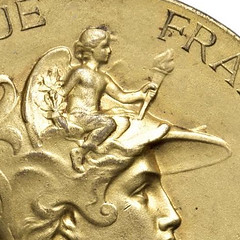 "The muse on the helmet appears to be like our Statue of Liberty with the torch lighting the way. Its location suggests to me the freedom of thought is the liberty being sought."
"The muse on the helmet appears to be like our Statue of Liberty with the torch lighting the way. Its location suggests to me the freedom of thought is the liberty being sought."
Thanks. -Editor
To read the earlier E-Sylum articles, see:
NUMISMATIC NUGGETS: JUNE 29, 2025 :
1912 France International Exhibition of Economics Medal
(https://www.coinbooks.org/v28/esylum_v28n26a20.html)
NOTES FROM E-SYLUM READERS: JULY 6, 2025
Inspired Genius, or Just Weird?
(https://www.coinbooks.org/v28/esylum_v28n27a09.html)
Menconi Ohio's Aerospace Pioneers Medal
Shirley Johnson writes:
"There is indeed a medal by Ralph J. Menconi like the recent drawing shown in The E-Sylum: Struck by Medallic Art Company (Maco # 1970-117) for the Ohio Junior Chamber of Commerce, Columbus, Ohio. It does appear in Dick's Databank on the Newman Portal."
Thank you. NOTE: NNP has been having issues lately fending off bots reading its contents to train artificial intelligence. It's been offline today, but the University is working on the issue. -Editor
To read the earlier E-Sylum article, see:
NUMISMATIC NUGGETS: JUNE 29, 2025 :
Prints of 1970 Menconi Ohio's Aerospace Pioneers Medal
(https://www.coinbooks.org/v28/esylum_v28n26a20.html)
Third Party Insurer Sought
Dick Hanscom of
Alaska Rare Coins writes:
"We have always used USPS for our high value packages. However, registered mail has become a problem, sometimes sitting in the Fairbanks P.O. for seven days before leaving town. When the shipment is 30K and we don't get paid until it gets there, this creates an obvious cash flow problem. COC would be nice, but that is not fair to the receiver (one registered package recently was lost, then found, and took six weeks to get there).
"COC is Cash on Confirmation (of shipping). I send a product, they send a check. Does not work when the shipment takes weeks to get there, while the check will show up in a few days.
"I would like to switch to FedEx. Can anyone recommend a 3rd party insurer?"
I Love My Coin Collection T-Shirt
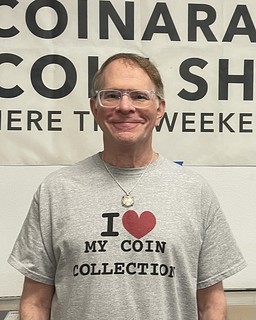 Ken Spindler of
San Diego writes:
Ken Spindler of
San Diego writes:
"This is me at a coin show earlier today wearing for the first time a t-shirt that I very recently had custom made for me... "
Cool look! Time to start selling merch. See this week's "About This Issue" article for my oddball t-shirt. -Editor
Fellow Numismatist Cartoon
I'm a fan of the Bizarro cartoons and Monday's cartoon has a numismatic flavor. My t-shirt in this week's "About This Issue" article is Bizarro merch. -Editor
On Facebook Dennis Tucker wrote:
"It looks like the book cover in this episode of Bizarro
was modeled after Whitman's classic blue coin folders!"
To read Dennis Tucker's Facebook post, see:
https://www.facebook.com/100000768993821/posts/23998403503101948/
2025 IAPN MADRID CONGRESS REPORT
The International Association of Professional Numismatists recently concluded a successful Congress in Madrid, Spain. Activities included adding new members, discussing tariff and regulatory issues, awarding the annual book prize, and confirming Rome as the site of the 75th anniversary Congress. -Garrett
The International Association of Professional Numismatists (IAPN) conducted its 73rd annual Congress in Madrid, Spain, from June 22-25, 2025. Forty-four member firms attended the event, held at the recently renovated Palace Hotel, a 1912 Art Nouveau masterpiece.
The Congress approved membership for six numismatic firms:
(1) Antium Aurum (Czech Republic)(https://www.antiumaurum.com/);
(2) Boardwalk Coins (USA)(https://boardwalknumismatics.com/);
(3) Capstone Acquisitions (USA) (https://capstonecoins.com/);
(4) A. Karamitsos International Auctions (Greece) (karamitsos@karamitsos.com);
(5) Rio de la Plata (Argentina) (https://rpnumis.com/); and
(6) Wessex Coins (United Kingdom) (https://www.wessexcoins.co.uk/).
Additionally, the Congress also approved an associate membership for CDN Publishing LLC (https://www.greysheet.com/).
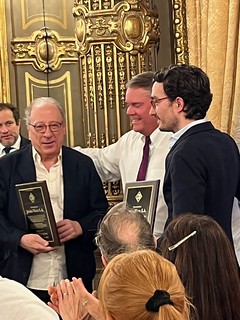 A moment of silence was also held for recently deceased IAPN members. These included Laszlo Nudelman, Gunnar Thesen, Eddy Absil, Druso Franceschi, and Claude Silberstein.
A moment of silence was also held for recently deceased IAPN members. These included Laszlo Nudelman, Gunnar Thesen, Eddy Absil, Druso Franceschi, and Claude Silberstein.
Congress delegates received briefings on regulatory challenges facing the industry as well as recent US tariffs.
The Congress voted to approve Rome as the location of its 74th Congress. That Congress will also mark IAPN's 75th anniversary. The Congress then heard proposals to hold subsequent Congresses in Hong Kong, South Africa, Argentina, and Saint Martin in the Caribbean.
Since 1982, IAPN has annually conducted its book prize award honoring numismatic authors for what the organization considers the best numismatic publication of the year
. This year, IAPN members reviewed 21 books on ancient, medieval, early modern, and modern coins as well as paper money published in 2024 before awarding top honors to Jean-Yves Kind for his 2 Volume set, Catalogue des Monnaies Royales Françaises. 1: Monnaies d'or Louis IX à Louis XII; 2: Monnaies d'or François Ier à Louis XVI. Second place went to Lucia Carbone for her Local Coinages in a Roman World: Second Century BC First Century AD. Third place went to Hugo Vanhoudt and John Saunders for their Gold Coinage of the Low Countries. More here: https://iapn-coins.org/general-news/13516732.
Jesús Vico Numismatic Auctions organized both the Congress and activities that included a welcoming reception at the Real Madrid Football Stadium, a companion tour of the Prado and Retiro Park, an evening tour of Toledo, and a Gala dinner at the Casa America in the 1877 Linares Palace.
At the Gala dinner, the firm received a special award from IAPN's president, Dan Sedwick, for its work in organizing the Congress, which had to be moved from its original location in Budapest, Hungary, due to the untimely death of its sponsor, Laszlo Nudelman. A total of 8465€ was also collected at the Gala for the Aladina Foundation, a charity to address the needs of children with cancer. More about the foundation can be found here: https://aladina.org/la-fundacion/.
For more information regarding the IAPN. please visit their website: https://www.iapn-coins.org/.
To read the complete article, see:
IAPN Conducts Successful Congress in Madrid
(https://www.iapn-coins.org/general-news/13517277)
To read an earlier E-Sylum article, see:
2025 IAPN BOOK PRIZES ANNOUNCED
(https://www.coinbooks.org/v28/esylum_v28n26a05.html)
VOCABULARY TERM: MEDALLIST, MEDALIST
Here's another entry from Dick Johnson's Encyclopedia of Coin and Medal Terminology. -Editor
Medallist, Medalist. A designer, engraver, maker or collector of medals; one knowledgeable in medals; also a recipient of a medal. As a creator of medallic art, the medallist must not only be a highly creative artist but also know the many techniques in the field. This talented person must be proficient in producing the patterns required for any medallic item and the working knowledge must include design, relief, the capabilities and limitations of die striking and art casting, and, certainly, patina finishes.
The first medallist was Pisanello, who in 1438 created the first sculpture of what was to be called a pendant medal, a portrait of John Palaeologus. Early medallists had to prepare the entire production of a medal, from pattern to casting the final item, and to patina it. They had to know, and do, every step themselves.
With the introduction of the screw presses for striking coins, in 1530, medals were also struck, but the diameter was necessarily small. Few medallists existed at this time. Those that did had to do their own engraving, by hand, and had some mint strike their creations. Thus medallists were concentrated at the national mints of Italy, France and England. One enterprising medallist from Belgium (a doctor!), Joseph Pierre Braemt (1796-1864) in 1824 even developed his own reducing machine, where he could model oversize and cut a medal die on his machine. Medallists since then have increased in number, as the appeal and demand for medallic art spread. It should be noted however, medallists have always been resourceful. This is lessened somewhat today with the ease of having private mints and medal makers produce what the medallist creates in his own workshop.
Famous medallists. In addition to Pisanello, famous early medallists include Donatello, Leonardo da Vinci, Benvenuto Cellini, Leone Leoni, all Italians, and somewhat later, the German engraver Albert Durer. In England Benedetto Pistrucci and the Wyon family of engravers were most noted. French medallists of note is quite lengthy, but mention should be made of David d'Angers, Augustin Dupré, Charpenter, Louis Roty, others. In America: Augustus St-Gaudens, Daniel Chester French, Guston Borglum, Herbert Adams, Laua Gardin and James Earle Fraser, Paul Manship, Frederick Macmonnies, Victor David Brenner, Anna Hyatt Huntington, many others, were famed for their medallic work.
For other meanings of medallist see MEDAL COLLECTING and RECIPIENT. The word is spelled with one or two lls – both are correct.
THE ONE LOT 1933 DOUBLE EAGLE AUCTION
E-Sylum Feature Writer and American Numismatic Biographies author Pete Smith submitted his article on the landmark 2002 sale of the Farouk specimen of the 1933 Double Eagle, which was originally published in The Northwest Angle, the newsletter for the Northwest Coin Club. We're republishing it here with permission. Thanks! -Editor
The One Lot Auction
In 2002, I attended the American Numismatic Association Convention at the Marriott Marquis
Hotel in Times Square in New York City. I was rooming with Harold Welch at the Milford Plaza,
The Lullaby of Broadway.
On our first night, we walked down to the Empire State Building
and went up to the observation deck. It was a lovely clear evening. I heard many clusters of
viewers talking, and none of them were speaking English.
On another day we took a bus downtown and got off at Trinity Church where Alexander Hamilton is buried. There were many 9-11 memorial markers placed in their fence. Harold and I walked to the site of The World Trade Center. By then the rubble had been removed leaving a large hole in the ground. Some nearby buildings were covered in plastic sheeting while waiting for repair. Later we walked past Federal Hall and the New York Stock Exchange.
The auction of a 1933 Double Eagle was scheduled at Sotheby's on the day before opening of the convention. This coin was thought to be unique and the only example that would ever be monetized and legal to own. It had been owned by King Farouk but was withdrawn before the auction of his collection and remained in Egypt after the auction. Dealer Stephen Fenton had acquired the coin in Europe and attempted to bring it back for sale in America, He was arrested by Secret Service agents who claimed ownership of the coin was illegal.
Legal proceedings dragged on for five years with the coin in a Treasury vault at the World Trade Center. Fenton showed that an export license had been issued on February 29, 1944, and signed by Secretary of the Treasury Henry C. Morgenthau. Ultimately the issue was settled with an agreement. The coin would be sold with Fenton receiving half of the money and the other half going to The Treasury Department.
On Tuesday, July 30, 2002, I caught a bus up to the Metropolitan Museum of Art in Central Park.
I spent about three hours walking around and noting things I had seen in my art history books.
My biggest impression was made by Emanuel Leutze's Washington Crossing the Delaware.
At
12' 5 by 21' 3, that thing is huge.
From there I walked over to Sotheby's. It was an easy walk but I was tired after three hours on my feet in the museum. I had a can of pop and a chocolate chip cookie in the reception area to rebuild some strength.
This was an important and historic numismatic event. The sale attracted a large crowd of observers interested in the sale. Like me, most had no thought of bidding on the coin.
The auction room was twice as large as needed for this sale. Two blocks of folding chairs were set up but already filled when I got there. I joined the rest of the standing room crowd at the back. [See white circle on photo] The photo may give the impression that the room was full. Actually, there was open space behind me with a row of people standing back by the windows.
Total crowd size probably exceeded three hundred and may have been more than five hundred. I didn't attempt to make a count.
There was a designated media area along the right side of the picture. As a member of the Numismatic Literary Guild, I might have been able to get media credentials if I had planned better in advance. I might have claimed I was a reporter for the Northwest Coin Club newsletter.
At the end of the room was a raised podium with the coin on display. From where I stood, it was a small gold dot. I never got close enough to really see it.
I don't recall seeing bid cards in the air during the sale. The main action was from bidder representatives on the phone with their clients. The sale took less than nine minutes. The final price was $7,590,020. The split gave Fenton $3,300,000 and the Treasury Department got $3.300,000. The auction companies got 15% or $990.000. The remaining $20 went to the Treasury Department.
Provisions of the sale required that the coin be monetized. The buyer's representative presented $20 to Henrietta Holsman Fore, Director of the Mint. She signed the paper monetizing the coin. I heard this happening but was not close enough to see any of it.
I shared a taxi for the ride back to the hotel with my good friend, ANA Librarian Nancy Green, and a casual acquaintance, ANA Convention Manager Ruthann Brettell.
The identity of the buyer would not be revealed for years. The coin was put on display at the New York Federal Reserve Bank. Later it was revealed that the buyer was Stuart Weitzman. He was a luxury shoe designer.
The coin came to auction again on June 8, 2021, in Sotheby's Three Treasures
sale. The sale
included the 1856 British Guiana One Cent Magenta stamp that sold for $8.3 million and the
plate block for the 1918 24-Cent Inverted Jenny
stamp that sold at $4.86 million. This time the
1933 Double Eagle realized $18,872,250. I did not attend this sale and was not the buyer.
To read the earlier E-Sylum articles, see:
FAROUK 1933 DOUBLE EAGLE RETURNS TO MARKET
(https://www.coinbooks.org/v24/esylum_v24n11a22.html)
THE FAROUK 1933 DOUBLE EAGLE
(https://www.coinbooks.org/v24/esylum_v24n21a24.html)
THE FAROUK 1933 DOUBLE EAGLE, PART 2
(https://www.coinbooks.org/v24/esylum_v24n22a20.html)
THE FAROUK 1933 DOUBLE EAGLE, PART 3
(https://www.coinbooks.org/v24/esylum_v24n24a17.html)
ADAM CRUM REMEMBERS RON LANDIS
Here is another remembrance of engraver Ron Landis from Adam Crum's Finest Known. This piece also discusses a fourth example of his coin reproductions, the Brasher Doubloon. -Garrett
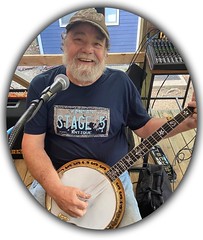 It is with heavy hearts that we mark the passing of Ron Landis, a master engraver, die sinker, and co-founder of the Gallery Mint Museum. A rare combination of artist, historian, and educator, Ron leaves behind a legacy that is as enduring as the coins and medals he so lovingly created.
It is with heavy hearts that we mark the passing of Ron Landis, a master engraver, die sinker, and co-founder of the Gallery Mint Museum. A rare combination of artist, historian, and educator, Ron leaves behind a legacy that is as enduring as the coins and medals he so lovingly created.
Ron was more than an engraver—he was a revivalist of lost techniques and a storyteller in metal. At the Gallery Mint Museum in Eureka Springs, Arkansas, he resurrected 18th- and 19th-century minting traditions, using hand-cut dies and antique screw presses to produce historically faithful recreations of iconic American coinage such as the 1849 $20 Liberty, 1804 Silver Dollar, and 1787 Brasher Doubloon.
Ron's talent reached the national stage when he was selected as a finalist in the design competition for the U.S. Golden Dollar in the 1990s. His graceful Liberty portrait reflected the classical beauty and technical precision that defined all his work.
I had the privilege of collaborating with Ron on several tribute issues crafted from California Gold Rush gold recovered from the legendary SS Central America. These included the 49'er Horseman, the 1852 Humbert $50 Octagonal, and the crowning piece of his career—his breathtaking rendering of the 1849 $20 Liberty, completed shortly before his passing. Each of these works stands as a tribute to Ron's devotion to both historical fidelity and artistic excellence.
More than his achievements, Ron will be remembered for his kindness, generosity, and mentorship. He inspired a generation of engravers and collectors through his humility, passion, and relentless pursuit of perfection.
Ron Landis was truly a once-in-a-generation talent. His hands shaped metal, but his heart shaped a community. His artistry will echo through time. He will be missed, but never forgotten.
To read the earlier E-Sylum article, see:
RONALD WAYNE LANDIS (1954-2025)
(https://www.coinbooks.org/v28/esylum_v28n25a05.html)
MORE ON RON LANDIS
(https://www.coinbooks.org/v28/esylum_v28n26a08.html)
1849 $20 CENTRAL AMERICA COMMEMORATIVE
(https://www.coinbooks.org/v28/esylum_v28n27a26.html)
THE LORD BALTIMORE SHILLING
In their latest email, Davisson's provided a history of the Lord Baltimore shilling highlighted in last week's E-Sylum. -Garrett
In 1632 Cecil Calvert, the second Baron Baltimore, inherited vast holdings of land in what would later become Maryland. In 1659, believing that his Royal Charter gave him the right to strike coins, he arranged for a small issue of coins to be produced in his name by the Royal Mint in London. His intent was to support the local agrarian economy, which was hampered by the need to use locally produced goods (especially tobacco) as barter in nearly all transactions.
There was some difficulty when it came time to export the coins to the Americas, and Calvert was arrested, the warrant issued by the Clerk of the Irons in the Mint stating that he "and diverse others with him, and for him, have made and transported great Sums of mony and doe still goe on to make more." The transport, and the fact that the coinage was minted at a lower (stirling) fineness from the official standards, seem to have led to the arrest. There are no records of how any proceedings may have gone, but they were seemingly short-lived and there are no records of further consequences, with Calvert living until 1675.
Initially designed to serve as a currency across the colonies, the coinage had largely disappeared by the 1700s, with many remaining examples holed for suspension. All examples are scarce to rare today.
To read the complete item description, see:
E-Auction 51 Lot 272
(https://davcoin.com/lot/e-auction-51-lot-272)
To read the earlier E-Sylum article, see:
DAVISSONS E-AUCTION 51
(https://www.coinbooks.org/v28/esylum_v28n27a19.html)
STACK'S BOWERS: RICK SPRINGFIELD SALE
Stack's Bowers will be selling the Rick Springfield Collection of United States Coins as part of their 2025 Summer Global Showcase Auction. Here is the press release. -Garrett
Stack's Bowers Galleries, America's oldest and most accomplished numismatic auctioneer, is honored to announce the upcoming auction of the Rick Springfield Collection. This magnificent cabinet of rare United States gold coins is a testament to the famed singer, songwriter, actor, and entertainer's passion for collecting and outstanding connoisseurship.
In building this highly focused selection of rare coins of about three dozen specimens, Mr. Springfield set out to assemble a world-class United States gold type set. His collection includes historically significant and high-grade specimens that reflect his appreciation for American heritage and numismatic excellence.
I always wanted to own some of the best coins from the best country in the best condition I could collect,
said Mr. Springfield.
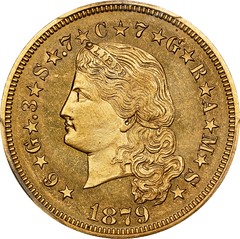
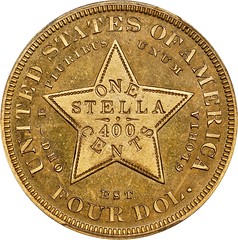
1879 Four-Dollar Gold Stella. Flowing Hair. Judd-1635, Pollock-1833, JD-1. Rarity-3. Gold. Reeded Edge. Proof-65 (PCGS). CAC. CMQ.
Exceptional highlights include:
- 1796 Capped Bust Right Quarter Eagle. No Stars on Obverse. BD-2. Rarity-4. AU-50 (PCGS).
- 1808 Capped Bust Left Quarter Eagle. BD-1. Rarity-4. EF-40 (PCGS).
- 1825 Capped Head Left Quarter Eagle. BD-2. Rarity-4+. MS-65 (NGC). CAC.
- 1833 Capped Head Left Quarter Eagle. BD-1. Rarity-5. MS-66 (PCGS).
- 1868 Three-Dollar Gold Piece. MS-67 PL (NGC).
- 1879 Four-Dollar Gold Stella. Flowing Hair. Judd-1635. Rarity-3. Proof-65 (PCGS). CAC. CMQ.
- 1796/5 Capped Bust Right Half Eagle. BD-1. Rarity-4+. MS-63 (NGC).
- 1806/4 Capped Bust Right Quarter Eagle. BD-1. Rarity-4+. Stars 8x5. MS-64 (NGC).
- 1833 Capped Head Left Half Eagle. BD-2. Rarity-6. MS-65 (PCGS).
- 1907 Indian Eagle. Wire Rim, Periods. Judd-1901. Rarity-3. MS-64+ (PCGS). CAC. CMQ.
- 1908 Indian Eagle. Motto. MS-68 (PCGS).
- MCMVII (1907) Saint-Gaudens Double Eagle. High Relief. Flat Rim. MS-67+ (PCGS).
We are thrilled to bring these incredible coins to market in our Summer Global Showcase Auction,
declared Brian Kendrella, President of Stack's Bowers Galleries. We look forward to offering this small but select group of numismatic treasures in an auction presentation that celebrates Mr. Springfield's commitment to quality and rarity.
We are the stewards of these historical items for a period in time,
Mr. Springfield stated. My hope is the next collector who takes possession will love them as much as I have. In fact, I'd like to personally meet the most significant buyer in this sale. To facilitate that meeting, I am giving the buyer two tickets and two VIP backstage passes to one of my concerts in the city of their choice. I look forward to sharing a coin story or two with them!
he concluded.
In this exclusive interview, Rick talks with David Hall (PCGS founder) about his collecting journey and why he's now auctioning his prized gold coin collection.
The 2025 Summer Global Showcase Auction, featuring the Rick Springfield Collection, will cross the block August 25-30 and September 2-5 in the firm's Griffin Studios, located in their Costa Mesa, California headquarters. The auction preview for this event is now online at Rick Springfield Collection. For more information call 800-458-4646 or email Info@StacksBowers.com.
About the consignor: Rick Springfield – A Legacy in Music and Pop Culture
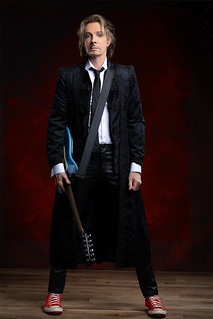 Rick Springfield, born Richard Lewis Springthorpe on August 23, 1949, in Guildford, New South Wales, Australia, is a multifaceted entertainer known for his achievements as a musician, actor, and author. His career spans six decades, marked by chart-topping hits, notable acting roles, and candid discussions about personal struggles.
Rick Springfield, born Richard Lewis Springthorpe on August 23, 1949, in Guildford, New South Wales, Australia, is a multifaceted entertainer known for his achievements as a musician, actor, and author. His career spans six decades, marked by chart-topping hits, notable acting roles, and candid discussions about personal struggles.
Springfield's upbringing was shaped by his father's career as a lieutenant colonel in the Australian Army, leading the family to relocate frequently across Australia and the UK. During his teenage years, he developed a passion for music, learning guitar at 13 and performing with various bands. In 1969, he joined the pop-rock group Zoot, gaining popularity in Australia. After the band's dissolution in 1971, Springfield embarked on a solo career, releasing his debut single Speak to the Sky,
which reached the top 10 in Australia in 1972.
Relocating to the United States, Springfield achieved international fame with his 1981 album Working Class Dog. The album featured the hit single Jessie's Girl,
which topped charts in both the U.S. and Australia and earned him a Grammy for Best Male Rock Vocal Performance. He followed this success with 17 Top 40 hits, including I've Done Everything for You,
Don't Talk to Strangers,
Affair of the Heart,
and Love Somebody.
His subsequent albums, such as Success Hasn't Spoiled Me Yet (1982) and Living in Oz (1983), solidified his status as a pop-rock icon.
Parallel to his music career, Springfield pursued acting. He gained widespread recognition for his role as Dr. Noah Drake on the daytime drama General Hospital from 1981 to 1983, with subsequent returns in later years. His film credits include the lead role in Hard to Hold (1984) and a co-starring role alongside Meryl Streep in Ricki and the Flash (2015). Springfield also took on roles in television series such as True Detective (2015), Supernatural (2016), and American Horror Story: Cult (2017).
Springfield remains very active in the entertainment industry. In 2021, he formed the supergroup The Red Locusts, releasing an album that pays homage to The Beatles and power pop bands of the 1980s and 1990s. He also hosts a weekly radio show, Working Class DJ with Rick Springfield, on Sirius XM's '80s on 8 Channel. In 2023, he released Volume 2 of his Greatest Hits album and continues to tour, demonstrating his enduring passion for music. He is currently headlining a tour with Wang Chung, John Waite, Paul Young, and John Cafferty and The Beaver Brown Band.
In 1984, Springfield married Barbara Porter, whom he met during the recording of Working Class Dog. The couple has two sons, Liam and Joshua. Springfield has been open about his lifelong battle with depression, candidly discussing his experiences in interviews and his 2010 memoir, Late, Late at Night, which became a New York Times bestseller. He has advocated for mental health awareness, sharing his journey to encourage others facing similar challenges.
Rick Springfield's multifaceted career and personal resilience have left an indelible mark on the entertainment world. From his chart-topping hits and memorable acting roles to his advocacy for mental health, Springfield's contributions continue to resonate with audiences worldwide.
Rick Springfield is an avid collector with a deep appreciation for vintage and pop culture memorabilia. Over the years, he has amassed an impressive collection of rare and nostalgic items, particularly from the science fiction and comic book realms. Among his most prized possessions are original Star Wars collectibles, action figures, and classic arcade machines. His love for collecting reflects a lifelong enthusiasm for fantasy, creativity, and preserving cultural touchstones from his youth. Springfield has occasionally showcased his collection during interviews and fan events, delighting audiences with his genuine geek passion and reverence for collectibles.
What a great collecting goal! Excellent coins, and another entry for our list of celebrity coin collectors. -Editor
ARCHIVES INTERNATIONAL SALE 104
Here are some selected lots from the July 23-24, 2025 sale by Archives International Auctions. -Garrett
Kharkov, Ukraine. Lot of 2 notes. 1918. Includes 1 Ruble, orange-brown and black and issued 5 Rubles, green and black. Both P-Unlisted. VF to XF condition. Scarce local notes.
To read the complete item description, see:
Kharkov, Ukraine. Lot of 2 notes. 1918. Includes 1 Ruble, orange-brown and black and issued 5 Rubles, green and black. Both P-Unlisted.
(https://auction.archivesinternational.com/Russia-Charkov-Saving-and-Loan-Partnership-Autocredit-1918-Scrip-Note-Pair_i57210408)
Providence, Rhode Island, 1796. 1 Ticket for 'such prize' Issued Lottery Ticket, Black print on brown paper, S/N 1715. PMG graded Choice Very Fine 35 with comment "Stained."
To read the complete item description, see:
Providence, Rhode Island, 1796. 1 Ticket for 'such prize' Issued Lottery Ticket, Black print on brown paper, S/N 1715.
(https://auction.archivesinternational.com/RI-Congregational-Meeting-House-Lottery-1796-Issued-Lottery-Ticket_i57210503)
San Francisco, California, 1874. $1 Gold Note 'in Payment for Photographs of Bearer' I/U Banknote, Black print with small boy at left and nature scene with elevated railway bridge at right. Back is brown with studio information. Bradley & Rulofson was a photo studio c._1850–1878 in San Francisco with Henry William Bradley (1813–1891) and William Herman Rulofson. Their studio was at 429 Montgomery Street. The California Historical Society - North Baker Research Library has a collection of their work. They made portraits and cabinet cards. Note is in Fine to VF condition with bottom right corner missing. Britton Rey & Co.
To read the complete item description, see:
San Francisco, California, 1874. $1 Gold Note 'in Payment for Photographs of Bearer' I/U Banknote, Black print with small boy at left and nature scene with elevated railway bridge at right.
(https://auction.archivesinternational.com/CA-Bradley-Rulofson-Photography-Advertising-Note-1874-Obsolete-Banknote_i57210505)
Providence, Rhode Island, ND (1830s-50s). $1, RI276G6P, Proof Banknote, Black printing with sailor at the help at top center and small child with corn at left and allegorical Native woman at right, POCs along bottom, PMG graded Choice Uncirculated 63, DTC. This is one of only two examples of this note listed in the PMG census of obsolete banknotes. From a new estate find that had been in the family since the 1890s. This is the first time this note has been offered at public auction.
To read the complete item description, see:
Providence, Rhode Island, ND (1830s-50s). $1, RI276G6P, Proof Banknote, Black printing with sailor at the help at top center and small child with corn at left and allegorical Native woman at right, POCs along bottom, PMG graded Choice Uncirculated 63, DTC.
(https://auction.archivesinternational.com/RI-Commercial-Bank-ND-1830s-50s-One-of-only-2-examples-known-Obsolete-Proof-Banknote_i57210523)
Washington, D.C., 1869 Counterfeit Bond Detector book with original plates by National BNC & American BNC. Includes 10 different bonds from different series, vignettes, counters and titles as well as alcohol, beer and cigar stamp proofs. Plates are in Extra Fine condition, the book has a broken binding with toning on pages and edges, still a rare and historic book with many useful and collectible bond plates.
To read the complete item description, see:
Washington, D.C., 1869 Counterfeit Bond Detector book with original plates by National BNC & American BNC.
(https://auction.archivesinternational.com/American-Bond-Detector-Book-1869-Counterfeit-Detector-Book-with-Proof-Bonds_i57210535)
Various States, 1870-1900s. Lot of 12 I/U and I/C Tickets and Passes from Various Railroad Lines. Includes: Lynn & Boston Transportation Co., Portland & Worcester Line, Bristol Line Fare, Yreka Railroad Co., Union Pacific Railroad Co., Bridgeton & Saco River R.R. and more. Tickets range from VF to XF condition. (12). Sold "AS IS" no returns accepted.
To read the complete item description, see:
Various States, 1870-1900s. Lot of 12 I/U and I/C Tickets and Passes from Various Railroad Lines.
(https://auction.archivesinternational.com/Railroad-Tickets-and-Passes-from-Various-Lines-1870s-to-1900s_i57210646)
New York. May 18, 1921, 25 Shares, I/U stock certificate, Black on brown border, impressive eagle vignette on top middle, Serial #310, Signed by Harry Houdini as president, Risley as treasurer, and issued to Christian Allen. VF to Choice VF condition. Printed by the Broun-Green Company.
To read the complete item description, see:
New York. May 18, 1921, 25 Shares, I/U stock certificate, Black on brown border, impressive eagle vignette on top middle, Serial #310, Signed by Harry Houdini as president, Risley as treasurer, and issued to Christian Allen.
(https://auction.archivesinternational.com/NY-Houdini-Picture-Corporation-1921-I-U-Stock-Certificate-Signed-by-Harry-Houdini-as-President_i57210681)
LOOTED CHINESE GOLD BARS SEIZED
The wreck of the French trading ship Le Prince de Conty was discovered in 1974, but was looted the following year. An American novelist and her husband are potentially facing trial in France over illegally selling looted gold bars. Thank you to Leon Saryan for submitting the article. -Garrett
An 80-year-old American novelist and her husband are among several people facing a possible trial in France over the illegal sale of gold bars plundered from an 18th-century shipwreck, after French prosecutors requested the case go to court.
Eleonor "Gay" Courter and her 82-year-old husband Philip have been accused of helping to sell the bullion online for a French diver who stole it decades ago, but have denied knowledge of any wrongdoing.
Le Prince de Conty, a French ship trading with Asia, sank off the coast of Brittany during a stormy night in the winter of 1746. Of the 229 men aboard, only 45 managed to survive, according to France's culture ministry.
Its wreck was discovered more than two centuries later, in 1974, lying in 30 to 50 feet of water near the island of Belle-Ile-en-Mer.
The wreck was looted in 1975 after a gold ingot was discovered during a site survey.
Some of the ship's looted gold bars eventually found their way to an auction in San Francisco, CBS Bay Area reported.
In 2018, the head of France's underwater archaeology department Michel L'Hour spotted a suspicious sale of five gold ingots on a U.S. auction house website.
He told U.S. authorities he believed they hailed from the Prince de Conty, and they seized the treasure, returning it to France in 2022.
Courter said she had been given the precious metal by a couple of French friends, Annette May Pesty, today 78, and her now deceased partner Gerard.
Pesty had told the "Antiques Roadshow" television series in 1999 that she discovered the gold while diving off the west African island of Cape Verde.
But investigators found this to be unlikely and instead focused on her brother-in-law, now 77-year-old underwater photographer Yves Gladu.
To read the complete article, see:
Stolen gold from 18th-century French shipwreck could lead to charges for U.S. novelist and her husband
(https://www.cbsnews.com/news/stolen-gold-french-shipwreck-us-couple-possible-trial/)
PRATT'S UNUSUAL INCUSE DESIGNS
A Greyheet article by Michael Garofalo discusses sculptor Bela Lyon Pratt and his innovative incuse designs for the the Quarter Eagle ($2.50) and Half Eagle ($5). Here's an excerpt - see the complete article online. -Editor
Dr. William Sturgis Bigelow was a close friend of President Roosevelt. He was one of the most pre-eminent experts on Japanese art and culture. On returning home to Boston after a long trip to Japan, Senator Henry Cabot Lodge, another friend of Bigelow's and of Pratt's, told Bigelow about the magnificent Saint-Gaudens coinage but also about the problems with the smaller denominations.
Bigelow wrote to Roosevelt, in January of 1908, and stated that he was working with a Boston sculptor on an idea that would permit coins to be struck in high relief but also be easily stackable for commerce. Roosevelt expressed his interest to Bigelow, who asked Pratt to go to work immediately on those two coins.
Pratt studied Saint-Gaudens' Double Eagle and the Eagle coin designs and was undoubtedly influenced by them. But unlike Saint-Gaudens' Eagle obverse, Pratt did not attempt to depict Miss Liberty wearing a headdress.
Instead, Pratt used a photograph of an unidentified male Native American as his inspiration for the obverse side of the coin. Pratt made several models of his design and sent one to Bigelow to present to Roosevelt. At a lunch meeting in April of 1908, Bigelow presented the design to Roosevelt, who was enthusiastically supportive of Pratt's design. That was all of the incentive that was required, and Pratt went about finishing his designs on both smaller coins.
Not only was Pratt's decision to use a photograph of a Native American man instead of an allegorical representation of Miss Liberty wearing a Native headdress imaginative, but the method of Pratt's actual design, using an incuse design rather than a high relief design protected by an even higher rim, was innovative and borderline extraordinary. No American coins had ever been struck using an incuse design.
On an incuse design, the design is ‘sunk into' the coin and is lower than the fields. Prior to these two coins, all coins had a relief design where the subject matter was higher than the connecting fields. The designs were, in theory and in practice, protected by a slightly higher edge rim.
The U.S. Mint typically did not like dramatic changes such as this, and many complaints about working with this design and the unlikelihood of it striking well were numerous from staff at the Philadelphia Mint.
By November of 1908, both of these denominations of coins were being struck and eventually released to the American public. But comments on both sides were plentiful and pointed.
In the November of 1908 issue of the American Numismatic Association's publication, The Numismatist, Howland Wood authored an article discussing the issue, and it was titled as THE BIGELOW-PRATT GOLD PIECES—NEW $2.50 AND $5.00.
Wood's article explained that the image of a real Native American, rather than a classical female head representing Liberty,
was used. Wood also explained, without negative comment, how an incuse design differs from the traditional design.
But just three months later, in the February 1909 issue of the same periodical, there was a scathing critique of these same coins by Philadelphia dealer S. H. Chapman. His article was penned in a letter to President Roosevelt, which attempted to discredit all aspects of the design. The design portrays an Indian who is emaciated,
was a complaint as Chapman also claimed that the coins could be easily counterfeited,
and would become a great receptacle for dirt and a conveyor of disease,
and the coins wouldn't stack but would fall when carried on a bank tray.
He advised the President to halt production and immediately recall these coins. Fortunately, Roosevelt did not follow Chapman's advice.
To read the complete article, see:
A Much Maligned, but Innovative Design
(https://www.greysheet.com/news/story/a-much-maligned-but-innovative-design)
THE CENT'S LEGACY
This article from CT Insider discusses the legacy of the cent and its history, and includes quotes from John Kraljevich and Seymour, CT dealer Ed Zehall. -Garrett
We pitch it, pinch it, squeeze and squander it. We stuff it in our loafers and offer it for our thoughts. A bad one always turns up and a pretty one is a splurge we heedlessly indulge. It's the penny — the numismatic dust bunny that collects at the bottom of coffee cans, lodges in the pocket of jeans and tumbles out of the dryer like an errant mitten.
Its days are numbered.
The Treasury Department stopped making blanks for pennies in May and will cease putting them into circulation next year, the Wall Street Journal reported. Economically, pennies are absurd; they cost four times more to make than what they are worth. But culturally, pennies are soldered into the social, linguistic and even military history of the country. Purging pennies from circulation may be easier than extirpating them from our language and lore.
Although most pennies today have little value — tossed into plastic jars and abandoned on cash registers — some pennies, especially those from the early American colonies, can sell for thousands of dollars, according to Gainsville Coins. In 2010, for instance, a New Jersey man sold a 1943-D Lincoln Bronze Cent for $1.7 million, the largest amount ever paid for a penny. As is the case with most valuable coins, that penny is prized because of a mistake. In 1943, the U.S. Mint needed copper for the war effort and consequently struck pennies in a special alloy of zinc-coated steel, said John Kraljevich, director of Numismatic Americana at Stack's Bowers Galleries. But a few slipped by and were struck on the usual copper discs left over from 1942, he said.
For more than 200 years, even before the United States was a nation, pennies represented an ideal — usually liberty, but also unity, symbolized by the 13-striped Union Shield
that has graced the penny since 2010.
You are communicating an idea and ideal of behavior, or a concept,
said Kraljevich, of Stack's Bowers.
Such associations date to antiquity, when, for instance, Alexander the Great issued a coin depicting him as the Greek hero Herakles.
Coins became a very important medium so that the government could widely spread a polemic or lots of polemics that would serve their needs,
Kraljevich said. If you want to show me what the sort of national perspective on itself and the rest of the world is, show me their coins.
Long before there was a U.S. Mint or the idea of a revolution began to simmer, British pounds, German thalers, Spanish milled dollars, and even some coins produced by individual colonies were the principal mode of financial exchange, according to the U.S. Mint. Each state minted its own pennies, now known as coppers,
or Fugio coppers,
each of which featured a different design, and most of which were used for small convenience items, such as a pound of sugar, Kaljevich noted.
They were never legal tender,
he said. They were made as a convenience for small-scale financial exchange.
None of these coins are intended to honor a person. Kaljevich said when the U.S. Senate was debating the 1792 Mint Act, it proposed putting an image of George Washington on a coin, an idea Washington vehemently rejected.
He didn't want to be a king,
Kaljevich said. "So, Lady Liberty stayed on the penny, in one form or another, for more than 60 years."
Employing such symbolism could result in the original intent of the coin being misinterpreted, he said. The Fugio Cent
or Franklin Cent,
which the Congress of the Confederation authorized in 1787, features a sundial on the front with the word Fugio,
(Latin for I fly
) and the phrase Mind your business.
Kraljevich said in the 18th century, I fly
referred to the sundial, a representation of time. And Mind your business
did not mean butt out,
but spend your time wisely, he said.
We're all delighted that they're no longer wasting money on pennies," Kraljevich said, "and they should probably kill the nickel, too."
To read the complete article, see:
The penny may soon be history, but the U.S. Mint can't stop the coin's American legacy
(https://www.ctinsider.com/living/article/penny-u-s-mint-valley-coins-seymour-20370318.php)
THE BOOK BAZARRE
COUNTERFEIT SWISS FRANCS FOUND IN KOSOVO
At a border crossing in Kosovo, officials confiscated a shipment of counterfeit Swiss Franc coins. -Editor
A suspected case of counterfeit money was discovered last night at the entrance to the border crossing in Han i Elezit.
According to the Police, after the initial check and verification of the documentation, the vehicle was selected for a detailed check. During this process, several plastic bags hidden under the front seats of the vehicle were discovered, filled with 2 Swiss Franc (CHF) coins, suspected to be counterfeit.
The relevant Police and Customs teams have conducted a preliminary inventory of the coins, where a total of 8,076 coins were counted, representing a total amount of 16,152 Swiss francs (CHF), all suspected to be counterfeit.
The suspect was detained for 48 hours by order of the Prosecutor for Serious Crimes and criminal proceedings were initiated against him for the offense of "Counterfeiting Money". The vehicle and coins were seized, while investigations are continuing by the competent regional investigation unit.
To read the complete article, see:
Caught with 16 thousand suspected counterfeit francs, S.XH from Skopje arrested
(https://kosovapress.com/en/caught-with-16-thousand-suspected-fake-francs--arrested-by-Skopje)
BANK OF ENGLAND TO CHANGE NOTE DESIGNS
The Bank of England could expand its banknote vignettes beyond just historical figures to include other symbols of national identity such as Stonehenge, oak trees, fish and chips, or football. -Garrett
The Bank of England may drop historical figures from banknotes as it seeks suggestions from the public on replacing Sir Winston Churchill, Jane Austen and JMW Turner.
Banknotes have featured notable historical figures since 1970, when William Shakespeare became the first person other than the monarch to be depicted.
Although notable historical figures remain an option, the Bank is expanding possible subjects to architecture and landmarks, arts, culture and sport, noteworthy events in history, technological innovations and nature. People who are alive, other than the monarch, will be excluded.
The public will be able to suggest their own ideas for themes or for people who should be included but the final decision will be made by the governor of the Bank, Andrew Bailey, to avoid the embarrassment of a Notey McNoteface
.
The consultation raises the potential for Stonehenge, oak trees, fish and chips or football to appear on notes. Cash in Scotland and Northern Ireland already carries images of landmarks and nature, such as otters.
A mock-up series of designs published alongside the consultation launch feature images of the Angel of the North, wind farms and the DNA double helix.
To read the complete article, see:
Churchill may be dropped from banknotes for diverse designs
(https://www.thetimes.com/business-money/money/article/churchill-banknotes-diverse-designs-22v2rmtqq)
See also:
Bank of England: Help us design our next series of banknotes
(https://www.bankofengland.co.uk/banknotes/help-us-design-our-next-series-of-banknotes)
One of these potential symbols, the bulldog, has gone under fire from animal rights groups, as they are, inherently unwell Frankendogs.
-Garrett
English bulldogs should not feature on new banknotes because they are inherently unwell Frankendogs
, an animal rights charity has claimed.
People for the Ethical Treatment of Animals (Peta) has appealed to the Bank of England after it launched a consultation into plans to redesign part of the nation's currency, urging the public to submit suggestions.
But in a letter to the Bank, Yvonne Taylor, Peta's vice-president of corporate projects, wrote: Brits are renowned for their love of dogs, but our involvement in the selective breeding of these ‘Frankendogs' is a national shame.
As a ‘breathing-impaired breed', British bulldogs have been deliberately bred to have extremely flattened snouts and tiny heads, which severely affect their health.
These unfortunate animals cannot draw enough air into their narrowed nostrils and often need to breathe through their mouths, leading them to snort, snore, and gasp. This condition can sometimes be fatal.
Ms Taylor added: Bulldogs and others bred to be inherently unwell are frequent visitors to the vet and, during the cost-of-living crisis, are at even greater risk of physical deterioration, neglect, abandonment, and even death if their guardians can't afford to keep addressing the maladies borne of their mutations.
The bulldog has long been seen as an emblem of Britain and its culture, featuring in art, postcards and cartoons, as well as being a common mascot in the Army and Navy.
However, the breed suffers from a range of health conditions, linked to extreme breeding for its trademark flat face, short snout and wide skull.
It's amusing to see the lengths some will go to in order to hitch a ride on someone else's story. No one said anything about dogs of any kind. Maybe we should put out a press release advocating for pictures of coins on the new banknotes. At least that's something that's happened a lot in the past and actually has a meaningful connection. Or we could vote for Notey McNoteface
.
-Editor
To read the complete article, see:
Ban bulldogs from new notes, Bank of England urged
(https://www.telegraph.co.uk/news/2025/07/12/ban-bulldogs-from-new-notes-bank-of-england-told/?ICID=continue_without_subscribing_reg_first)
To read the earlier E-Sylum article, see:
ENGLISH BREAKFAST CONSIDERED FOR COIN DESIGN
(https://coinbooks.org/v20/esylum_v20n09a18.html)
CULTURAL CURRENCY MONEY ART EXHIBIT
The City of Lake Charles, Louisiana is the latest host of the travelling exhibit of money art we discussed last year. -Editor
The innovative exhibit, Cultural Currency: Contemporary Art from the Riemer Collection,
explores the ways value and worth extend beyond the dollar bill. Artists repurpose physical pieces of money, like bills and coins, and transform them into introspective works of art.
It offers a compelling lens through which to examine our relationship with money, something so central to daily life, yet rarely questioned beyond its purchasing power,
said Payton Lundmark, director of cultural affairs for the City of Lake Charles. The exhibition aligns with Historic City Hall's mission to showcase meaningful contemporary art that challenges conventional thinking and sparks dialogue around culture, identity and value.
Cultural Currency
will be exhibited until Aug. 23 from 10 a.m.-6 p.m. Tuesday through Friday and 10 a.m.-2 p.m. Saturday. Admission is free.
The collection was curated by Davis Riemer and Louise Rothman-Riemer, investment advisers from Oakland, California. Lundmark said their passion for collecting money-themed pieces of art began in 1995 when they wanted to create new attitudes towards the value of money.
The exhibit, she said, encourages audiences to take a step back and reevaluate the concept of money. After visiting the exhibit, patrons will see currency as more than just a transactional tool,
she said.
Through the artists' creative reimagining of currency, viewers are invited to reflect on how we assign worth, not just to money, but to people, ideas and experiences,
Lundmark said. The exhibition also encourages personal introspection: What does money mean to us emotionally? How does it shape our identity, our politics, our sense of power and security?
The display features a variety of media, including sculpture, collage, textiles, paint and print.
The exhibit includes 65 artworks by 38 artists: Lou Beach, Alice Beasley, Ray Beldner, Barton Lidice Beneš, J.S.G. Boggs, Enrique Chagoya, Robin Clark, Sonya Clark, Rob Cohen, Don and Era Farnsworth, Kathy Hall, Kelli Hoppmann, Lenny Kislin, Lisa Kokin, Marcella Lassen, Jean Lowe, Rene Megroz, Aerosyn-Lex Meštrovic, Alejandro Monge, Richard Newill, Francesca Pastine, Walter Robinson, Paul Rousso, Azin Seraj, Richard Sexton, Richard Shaw, Oliver Smith, Sally Smith, Oriane Stender, Jill Sylvia, Dan Tague, Kim Testone, Robert Mark Wagner, Stacey Lee Webber, Marshall Weber and C.K. Wilde.
To read the complete article, see:
Made of Money: Artists examine deeper meaning of currency
(https://americanpress.com/2025/07/10/made-of-money-artists-examine-deeper-meaning-of-currency/)
To read the earlier E-Sylum article, see:
CULTURAL CURRENCY MONEY ART EXHIBIT
(https://www.coinbooks.org/v27/esylum_v27n42a15.html)
ABOUT THIS ISSUE: JULY 13, 2025
Busy week this time - I was working on transitioning our email list to the MailChimp platform while also keeping track of quarterly payments from our advertisers. Thursday evening Len Augsburger and Bruce Perdue were on a video call with me while I walked Bruce through how to publish an issue on the new platform. The transition should be seamless for readers and we hope to complete it this summer.
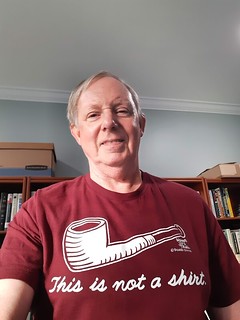 On Friday night I got a text from Garrett wondering if I'd have any articles for him to work on. Crap!! - I'd been so busy I'd forgotten. First thing Saturday I sent him several items that he turned around that day for this issue. Later that morning I learned of the passing of George Kolbe and dropped everything to work on our lead article for the week.
On Friday night I got a text from Garrett wondering if I'd have any articles for him to work on. Crap!! - I'd been so busy I'd forgotten. First thing Saturday I sent him several items that he turned around that day for this issue. Later that morning I learned of the passing of George Kolbe and dropped everything to work on our lead article for the week.
That evening I worked on the money art exhibit story and just had to take this selfie to show my t-shirt for the day, a cartoon nod to Belgian surrealist painter René Magritte, whose work was also echoed in one of the money art works. Our daughter had no clue when she saw my shirt that morning, but she's majoring in nursing, not art history, so I gave her a pass.
If the below photo were numismatic it would be a shoo-in for Image of the Week. I ran across it Saturday morning. My caption would be "Prototype of the world's first hearing aids." Have a great week. -Editor
Wayne Homren
Wayne Homren is the founding editor of The E-Sylum and a consultant for the Newman Numismatic Portal. His collecting interests at various times included U.S. Encased Postage Stamps, merchant counterstamps, Pittsburgh Obsolete paper money, Civil War tokens and scrip, Carnegie Hero Medals, charge coins and numismatic literature. He also collects and has given presentations on the work of Money Artist J.S.G. Boggs. In the non-numismatic world he's worked in artificial intelligence, data science, and as a Program Manager for the U.S. Department of Defense.
Garrett Ziss
Garrett Ziss is a numismatic collector and researcher, with a focus on American paper money and early U.S. silver and copper coins. He is also a part-time U.S. coin cataloger for Heritage Auctions. Garrett assists Editor Wayne Homren by editing and formatting a selection of articles and images each week. When he's not engaged in numismatics, Garrett is pursuing a Master's Degree in Quantitative Economics at the University of Pittsburgh.
Pete Smith
Numismatic researcher and author Pete Smith of Minnesota has written about early American coppers, Vermont coinage, numismatic literature, tokens and medals, the history of the U.S. Mint and much more. Author of American Numismatic Biographies, he contributes original articles to The E-Sylum often highlighting interesting figures in American numismatic history.
Greg Bennick
Greg Bennick (www.gregbennick.com) is a keynote speaker and long time coin collector with a focus on major mint error coins and US counterstamps. He is on the board of both CONECA and TAMS and enjoys having in-depth conversations with prominent numismatists from all areas of the hobby. Have ideas for other interviewees? Contact him anytime on the web or via instagram
@minterrors.
John Nebel
Numismatist, photographer, and ANS Board member and Fellow John Nebel of Boulder, CO helped the ANA and other clubs like NBS get online in the early days of the internet, hosting websites gratis through his Computer Systems Design Co. To this day he hosts some 50 ANA member club sites along with our
coinbooks.org site, making the club and our E-Sylum archive available to collectors and researchers worldwide.
Bruce Perdue
Encased coinage collector (encasedcoins.info) Bruce Perdue of Aurora, Illinois has been the volunteer NBS webmaster from its early days and works each week to add the latest E-Sylum issue to our archive and send out the email announcement.

